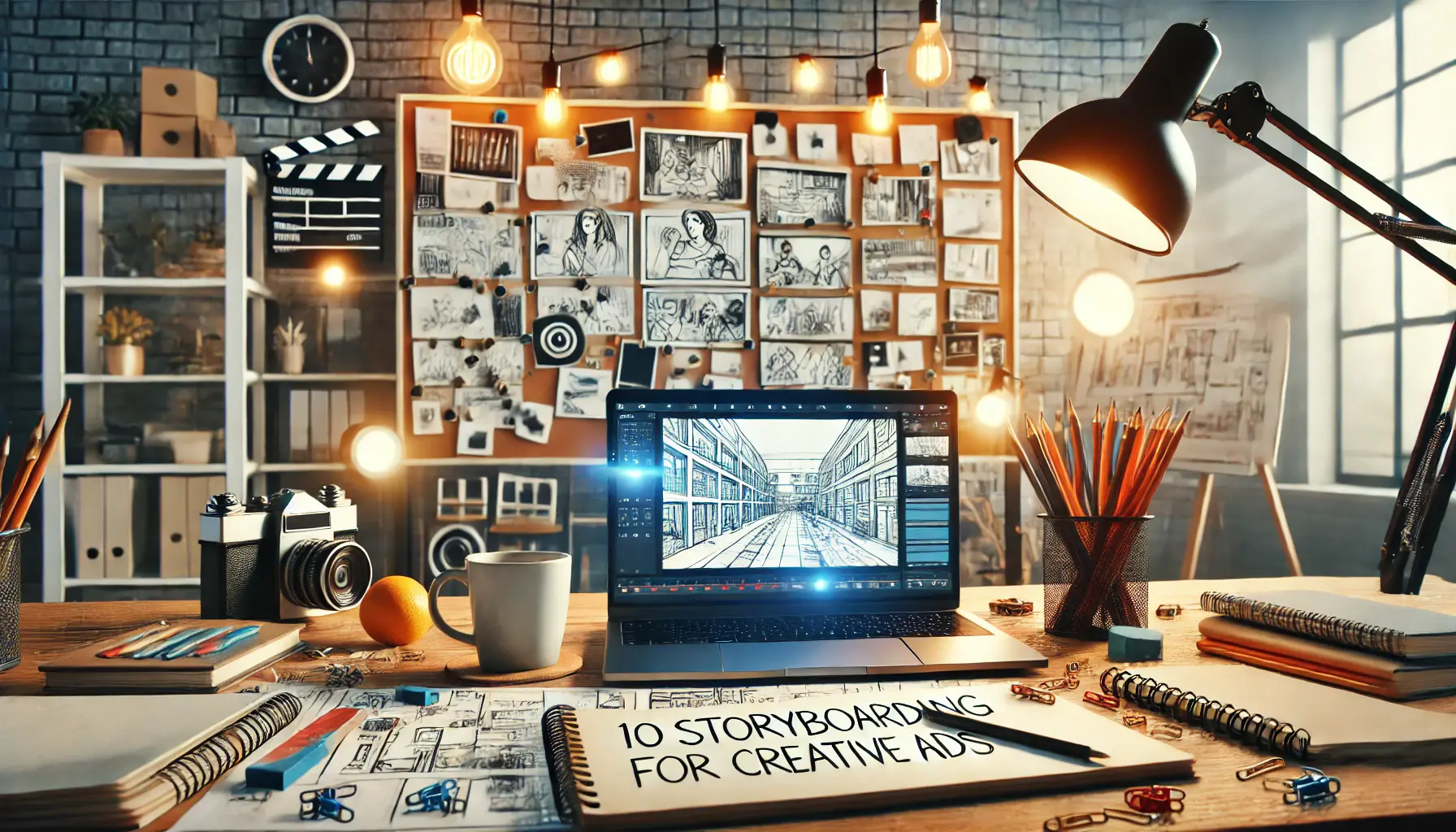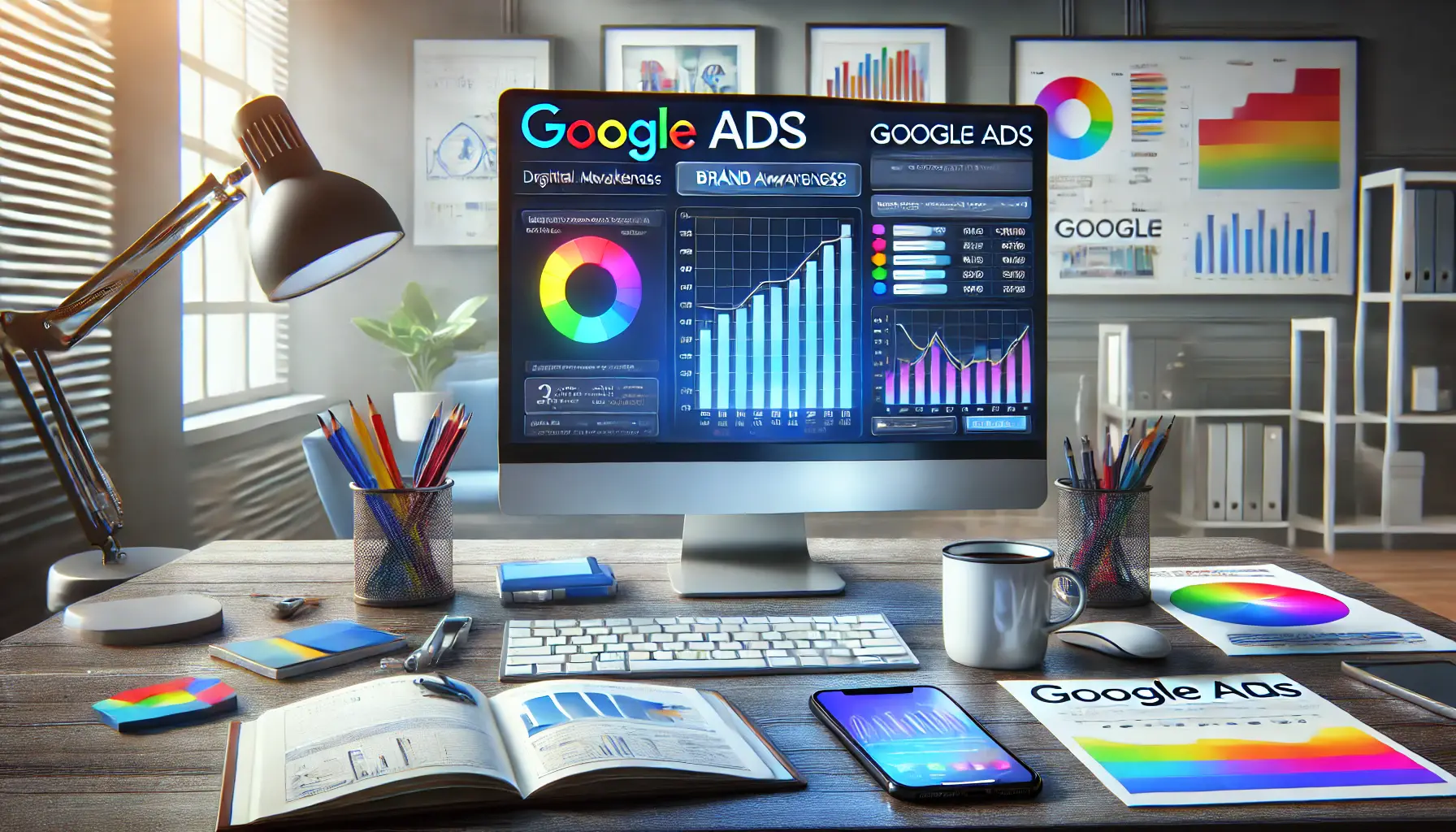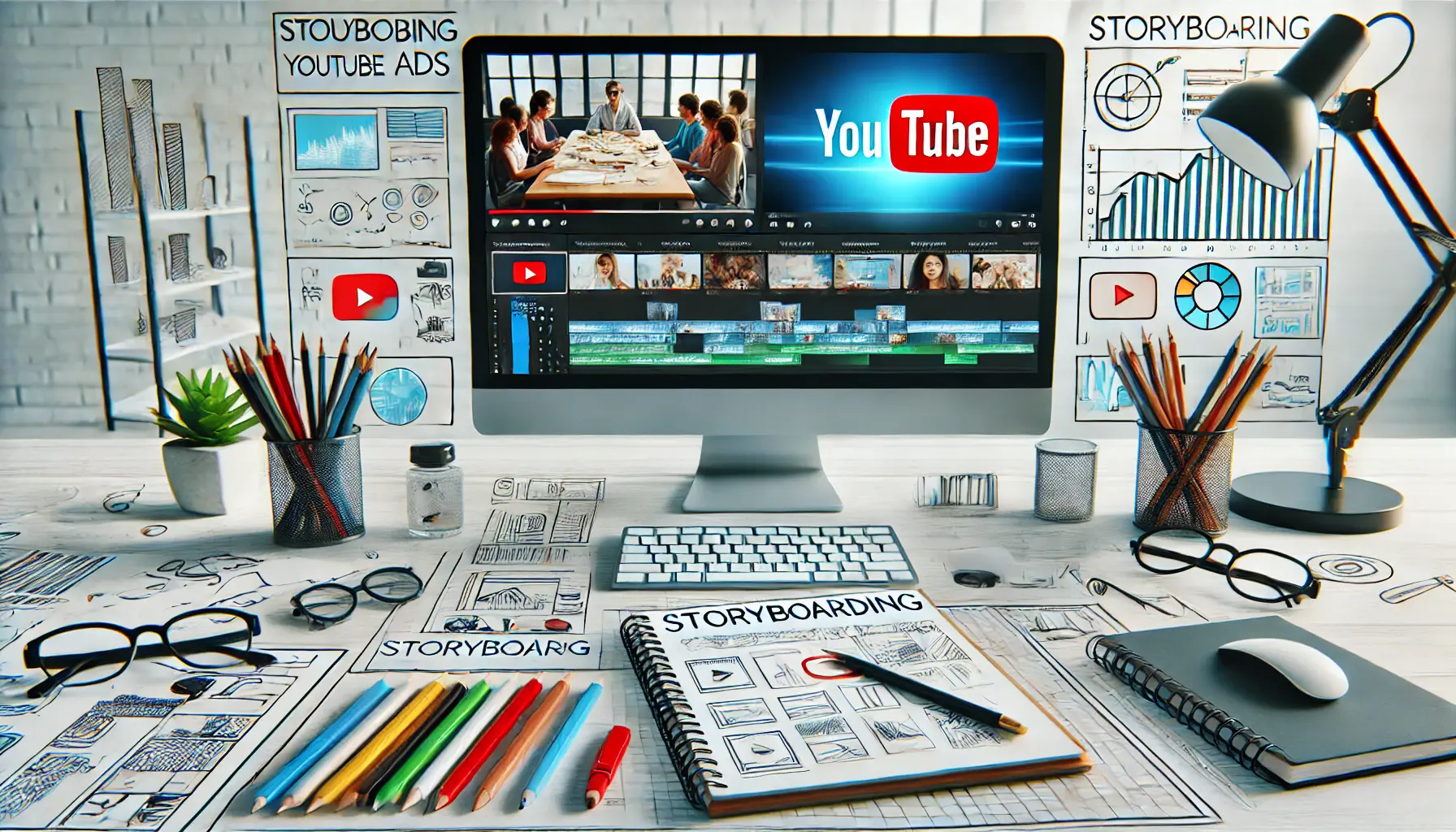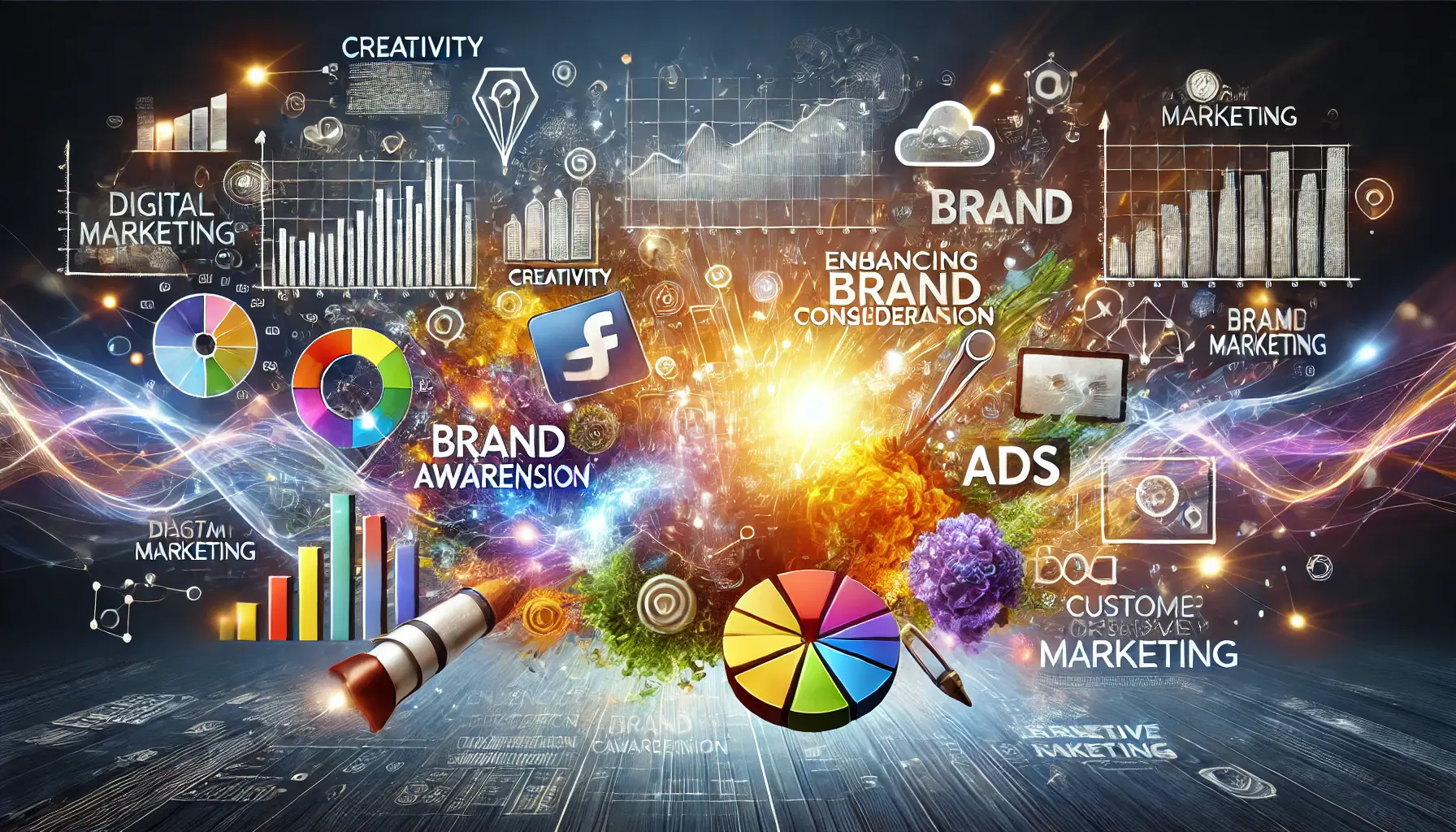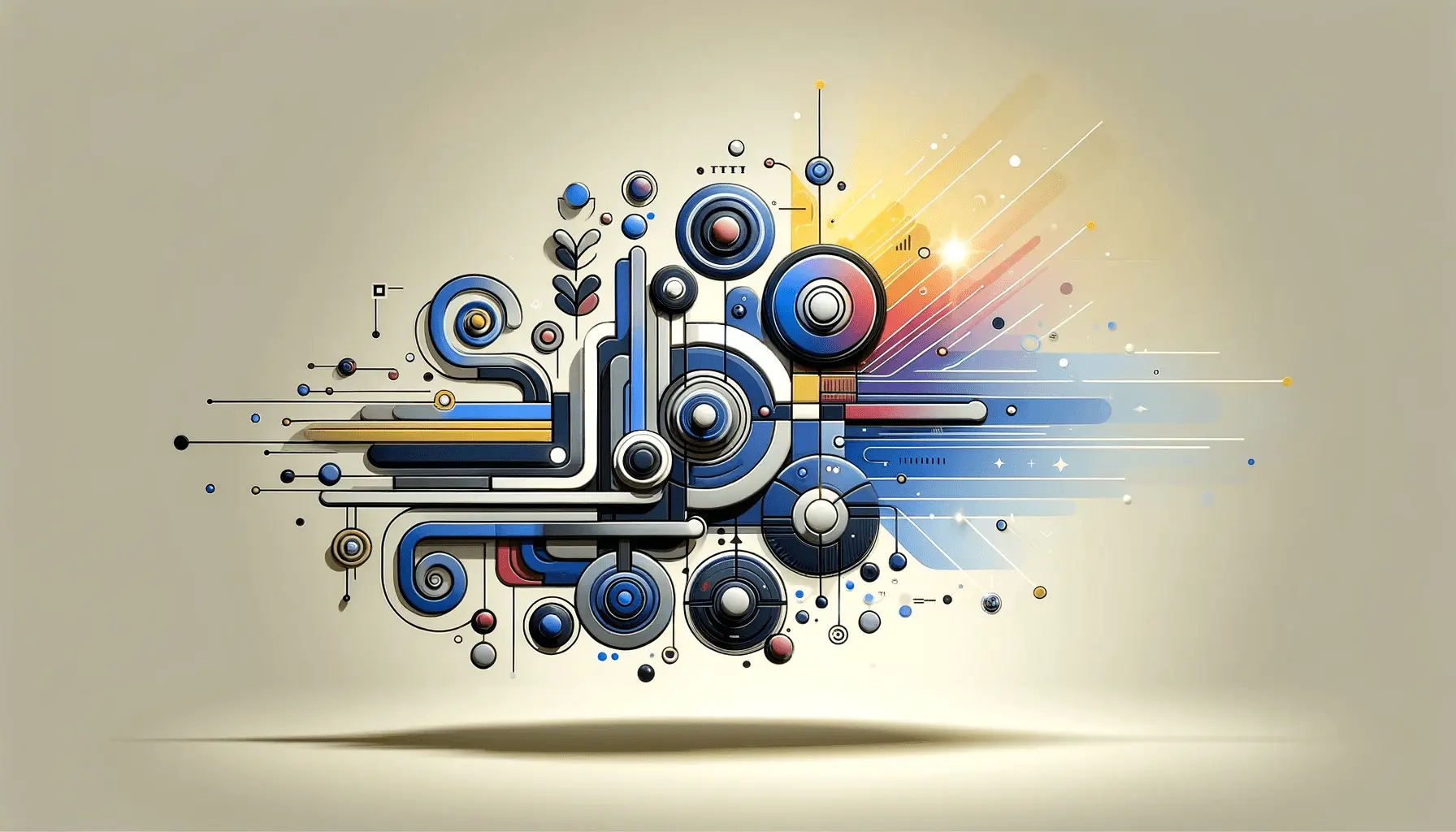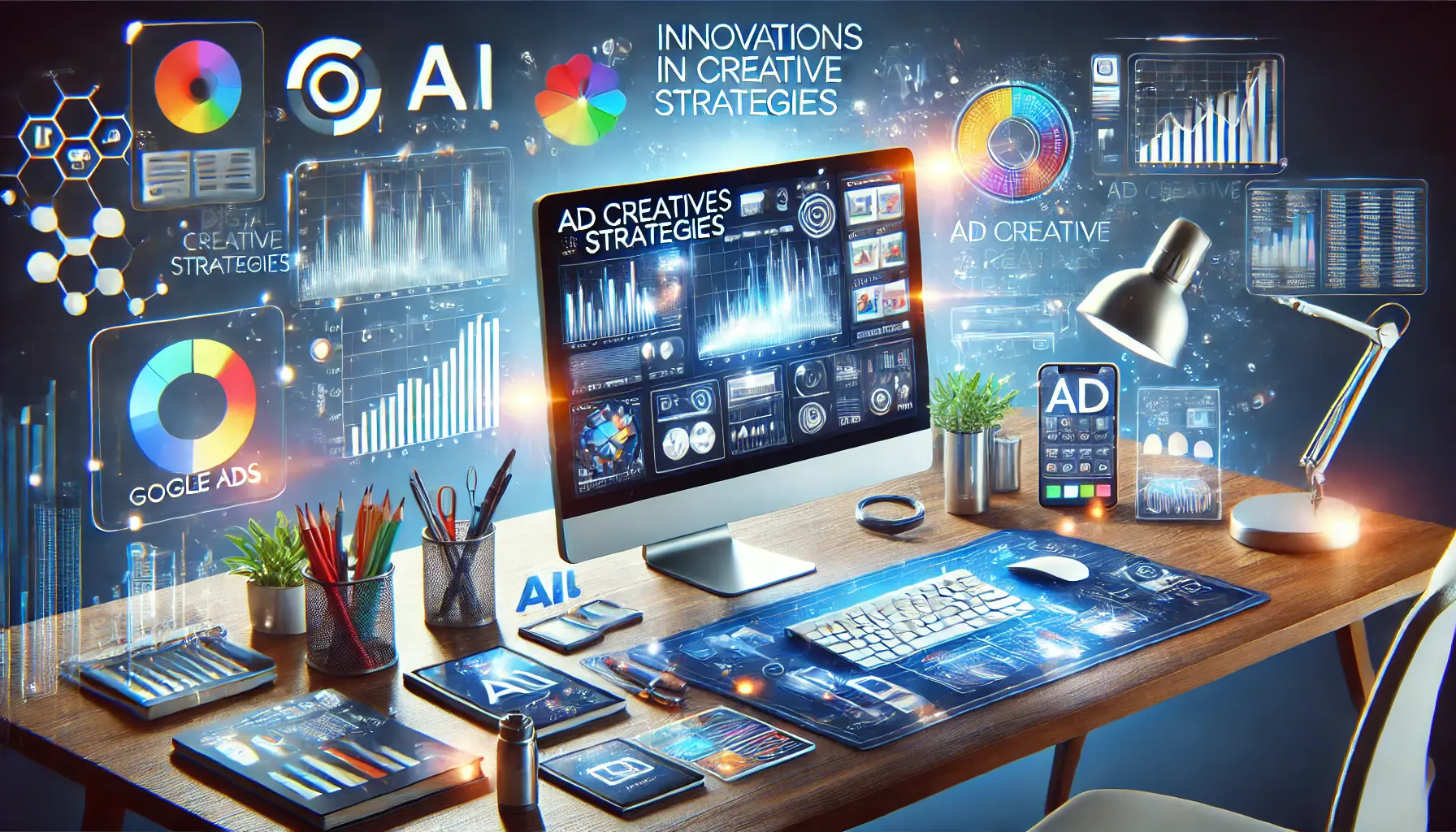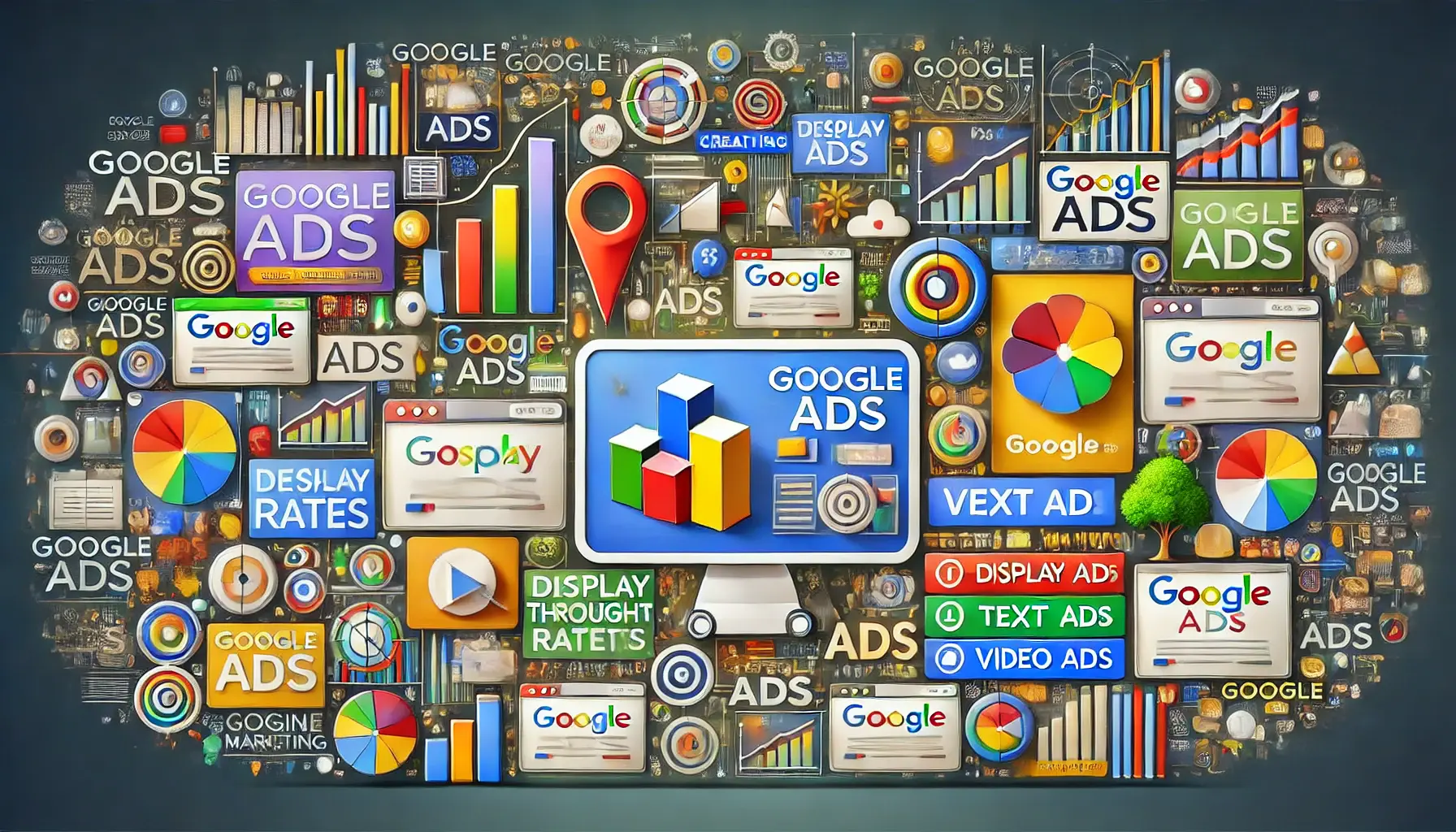In the world of fast-paced advertising, holding your audience’s attention is crucial.
How do you ensure that your ad is engaging yet effective?
It is all about meticulous planning, and that’s where storyboardingThe process of creating a visual representation of an ad or video sequence through sketches or frames. techniques come into play.
By visualizing what will happen in the ad, you can create a plan for compelling content that resonates with the viewer.
Let’s delve into the significance of storyboarding techniques in advertising and how they can elevate your creative campaigns.
- Understanding the Importance of Storyboarding in Advertising
- Essential Elements of an Effective Storyboard
- Top 10 Storyboarding Techniques for Engaging Advertisements
- Case Studies: Successful Ad Campaigns Using Storyboarding
- Best Practices for Effective Storyboarding in Advertising
- Conclusion: Mastering Storyboarding Techniques for Advertising Success
- Frequently Asked Questions about Storyboarding Techniques
Understanding the Importance of Storyboarding in Advertising
Storyboarding is a crucial step in the ad creation process.
It involves sketching out each scene of your advertisement, much like a comic strip, to visualize the flow and structure before production begins.
This technique allows you to plan every detail, ensuring a cohesive and compelling narrativeThe structured sequence of events or storytelling in a piece of content. that aligns with your brand’s message.
Imagine trying to shoot a commercial without a clear plan.
It would be chaotic, time-consuming, and likely result in a disjointed final product.
Storyboarding techniques eliminate this chaos by providing a clear roadmap for your project.
They help you organize your ideas, streamline the production process, and avoid costly mistakes.
More importantly, storyboarding techniques facilitate better communication within your creative team.
When everyone can see a visual representation of the concept, providing feedback, making adjustments, and ensuring all team members are on the same page becomes much easier.
This collaborative effort makes the advertisement more polished and efficient.
In my experience, taking the time to storyboard has always paid off.
It clarifies the vision and uncovers potential challenges early on, allowing for proactive solutions.
Have you ever started a project without knowing what you were getting yourself into and then hit unexpected bumps?
Storyboarding techniques can help you avoid such scenarios, making the advertising process more effective and efficient.
The next time you’re preparing for a new ad campaign, create a storyboard.
This powerful tool will turn your creative ideas into successful advertisements, ensuring a seamless production process and a captivating final product.
Storyboarding bridges the gap between concept and execution, ensuring a smooth production process and a cohesive final advertisement.
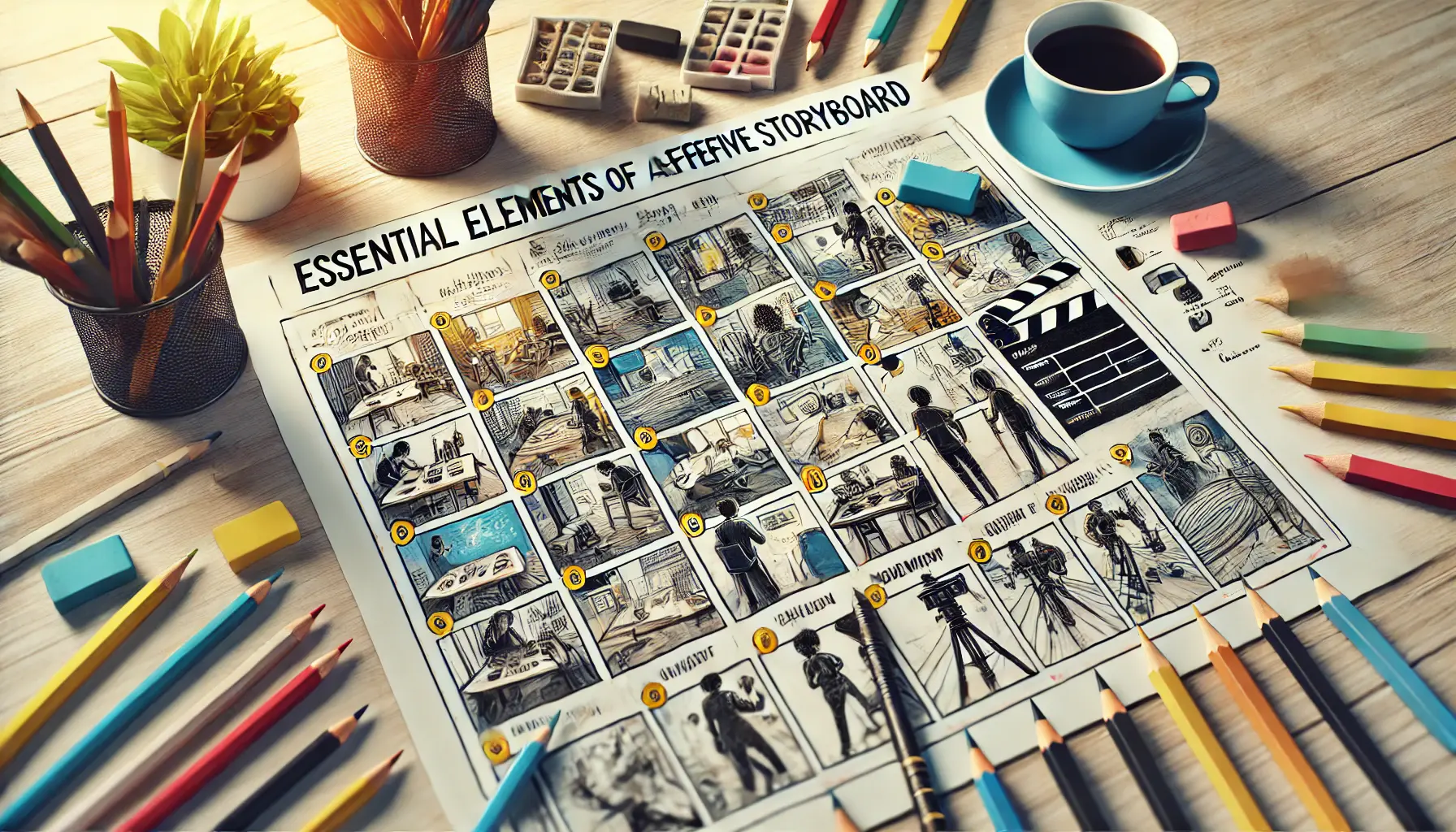
An organized workspace featuring the essential elements of a professional storyboard.
Essential Elements of an Effective Storyboard
Creating a compelling advertisement requires meticulous planning, and a well-crafted storyboard is at the heart of this process.
By incorporating key elements, you can ensure your storyboard effectively communicates your vision and guides your production team seamlessly.

A detailed workspace showcasing visual frames as essential elements of a storyboard.
1. Visual Frames
Each frame in your storyboard should represent a distinct scene or shot, illustrating the progression of your advertisement.
These frames act as a visual roadmap, helping to convey the narrative flow and key moments of your ad.
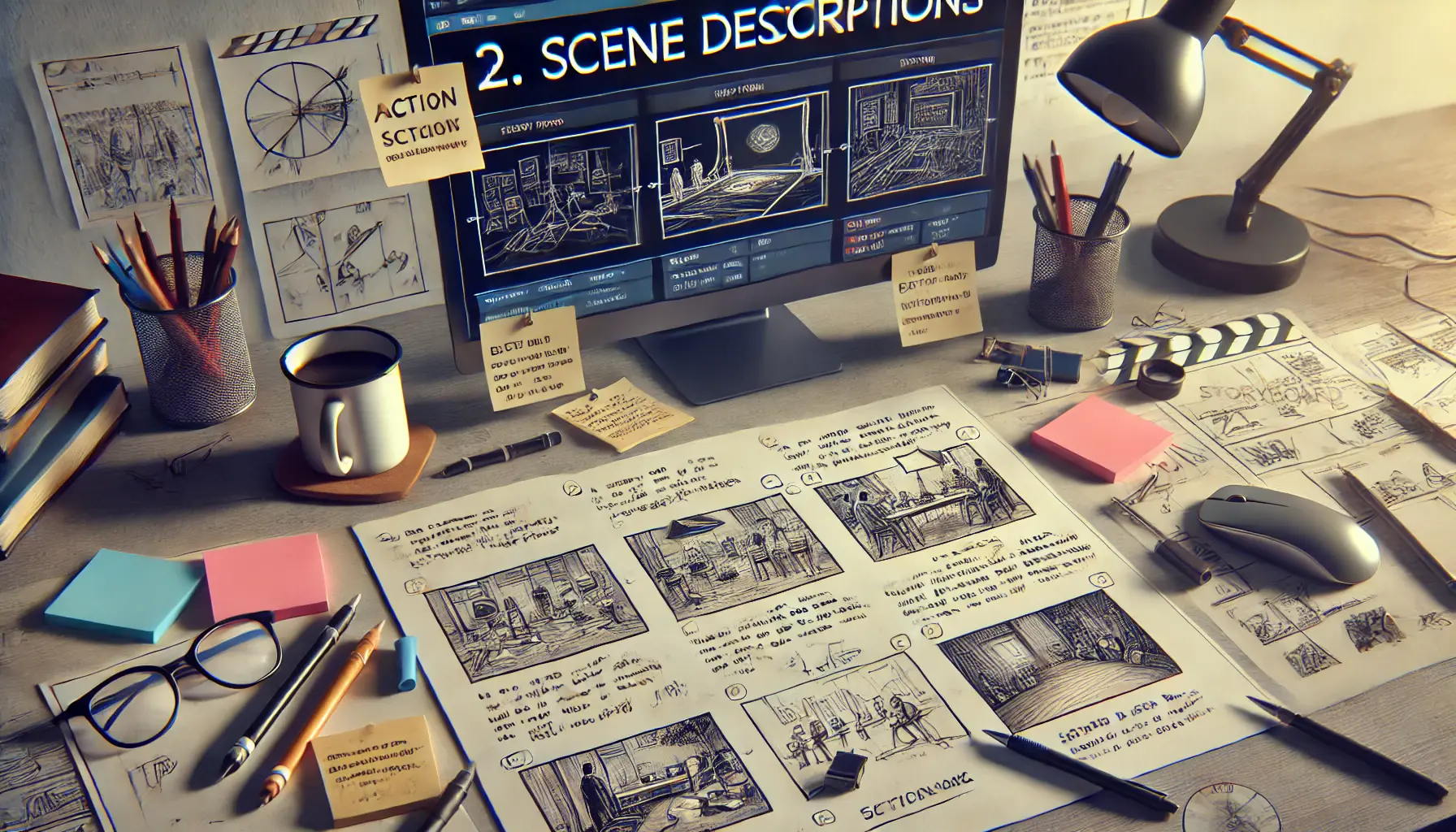
A professional setup highlighting the importance of scene descriptions in a storyboard.
2. Scene Descriptions
Accompanying each visual frame, concise descriptions should detail the action, setting, and any critical elements within the scene.
This ensures that everyone involved understands the context and objectives of each shot.
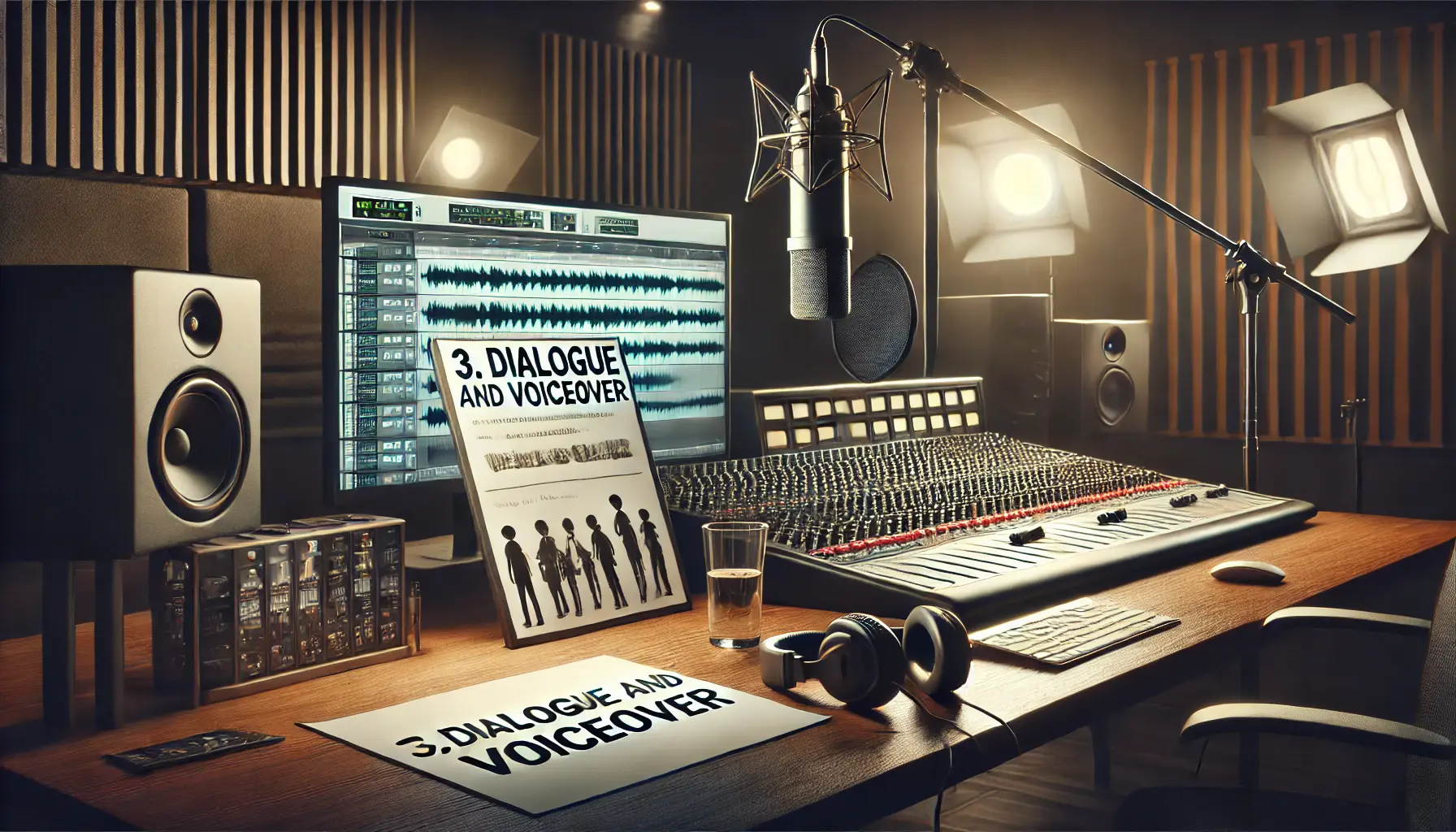
A recording studio setup highlighting the importance of dialogue and voiceover in storyboarding.
3. Dialogue and Voiceover
If your advertisement features dialogue or voiceover, include the exact wording in the appropriate frames.
This helps synchronize the visuals with the script, creating a coherent and impactful message.
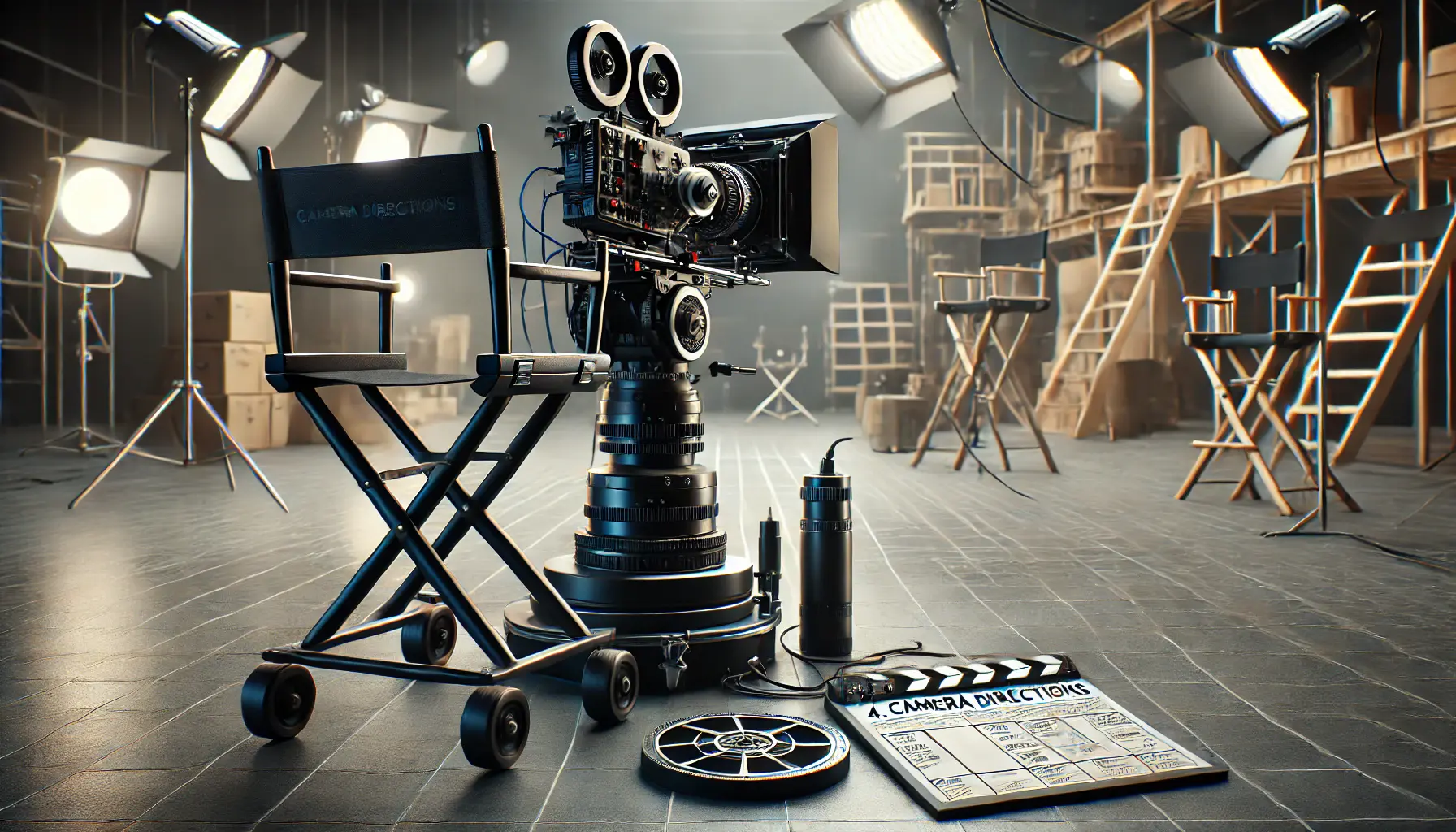
A film set showcasing camera equipment and storyboard with camera directions.
4. Camera Directions
Mention the camera angles, movements, and shot types for every scene.
Indicate whether the shot is a close-up, wide-angle, or involves camera movement.
This gives clarity to the production team and aligns with the intended visual storytelling.
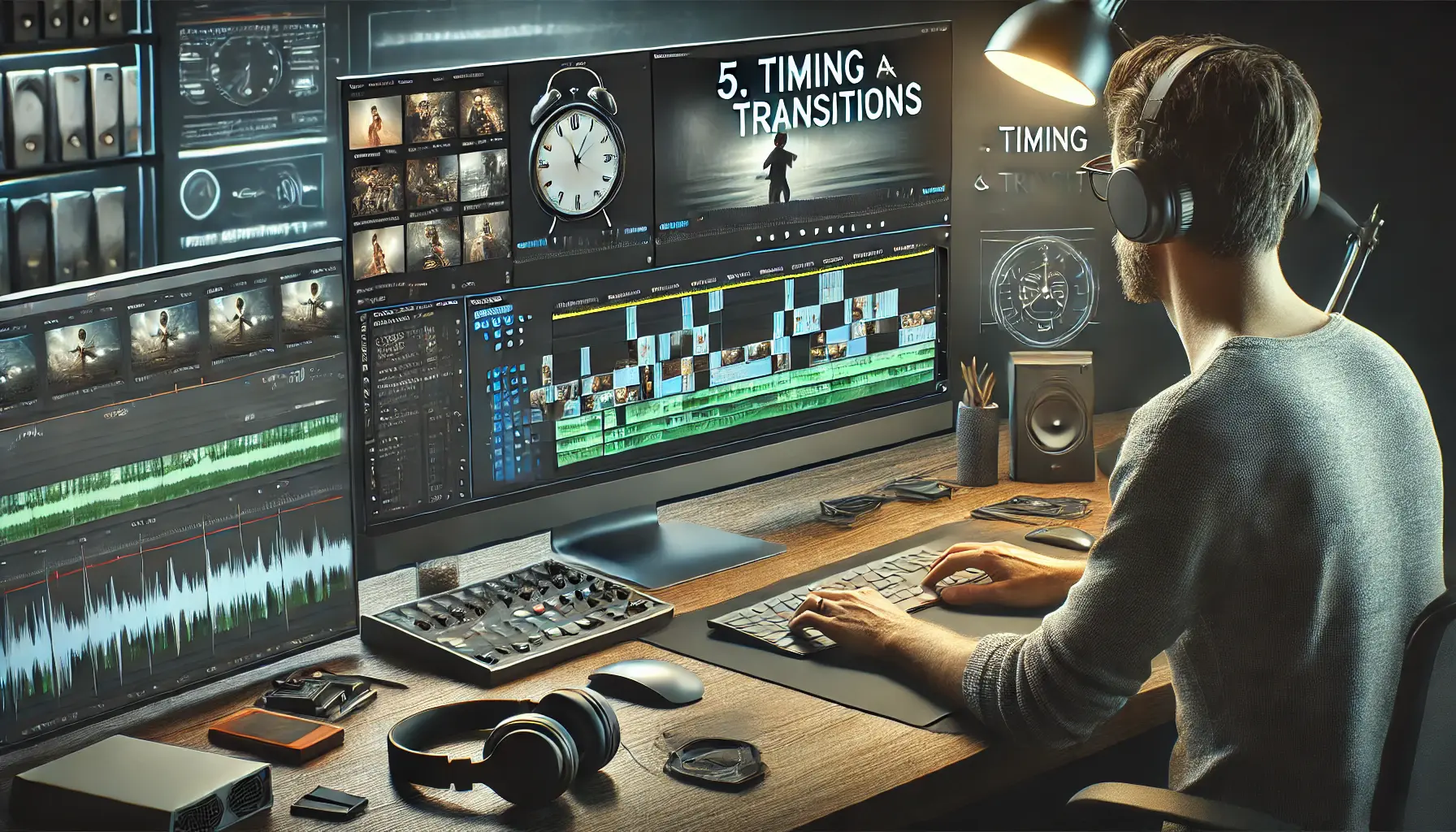
A professional video editing workspace showcasing timing and transition effects.
5. Timing and Transitions
Note the duration of each shot and how scenes transition from one to the next.
Whether it’s a cut, fade, or dissolve, detailing transitionsTechniques used to move smoothly from one scene or frame to another in visual media. aids in establishing the pacing and flow of the advertisement.
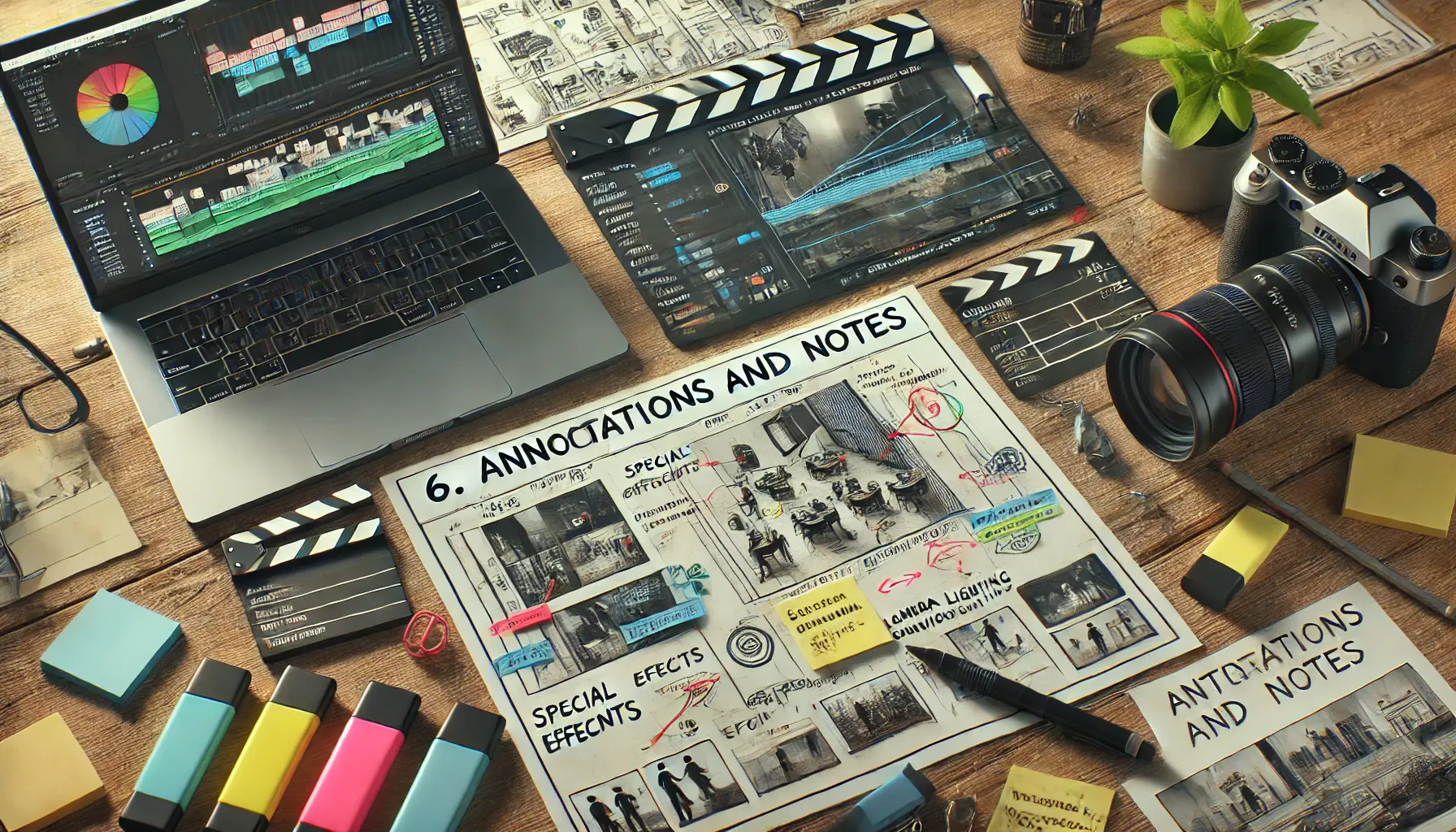
A professional workspace emphasizing the importance of annotations and notes in storyboarding.
6. Annotations and Notes
Notes may also include special effects, lighting, or specific camera actions.
These annotations further guide the production team to ensure every element works together seamlessly toward the final result.
By incorporating all these factors into a storyboard, you create a comprehensive workbook that enables more effective collaboration with your team.
This approach results in a stronger, more cohesive advertisement that resonates with your audience.
- Include detailed scene descriptions for clarity.
- Incorporate camera directions to guide the production team.
- Plan transitions and timings to ensure a seamless flow.
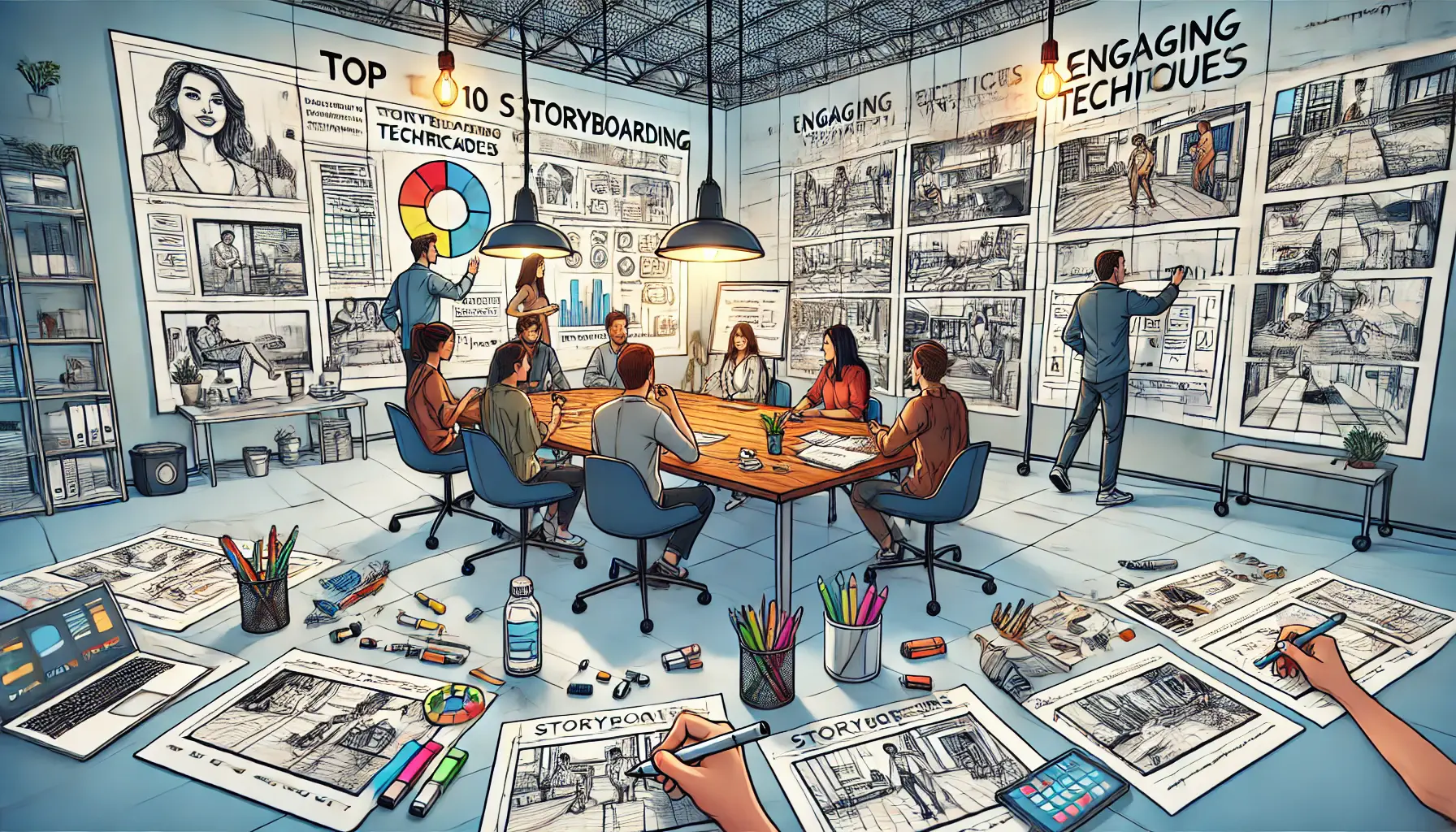
A collaborative brainstorming session highlighting top storyboarding techniques for engaging advertisements.
Top 10 Storyboarding Techniques for Engaging Advertisements
Creating an engaging advertisement requires meticulous planning and innovative storyboarding techniques.
By implementing the following methods, you can craft compelling narratives that captivate your audience and effectively convey your brand’s message.
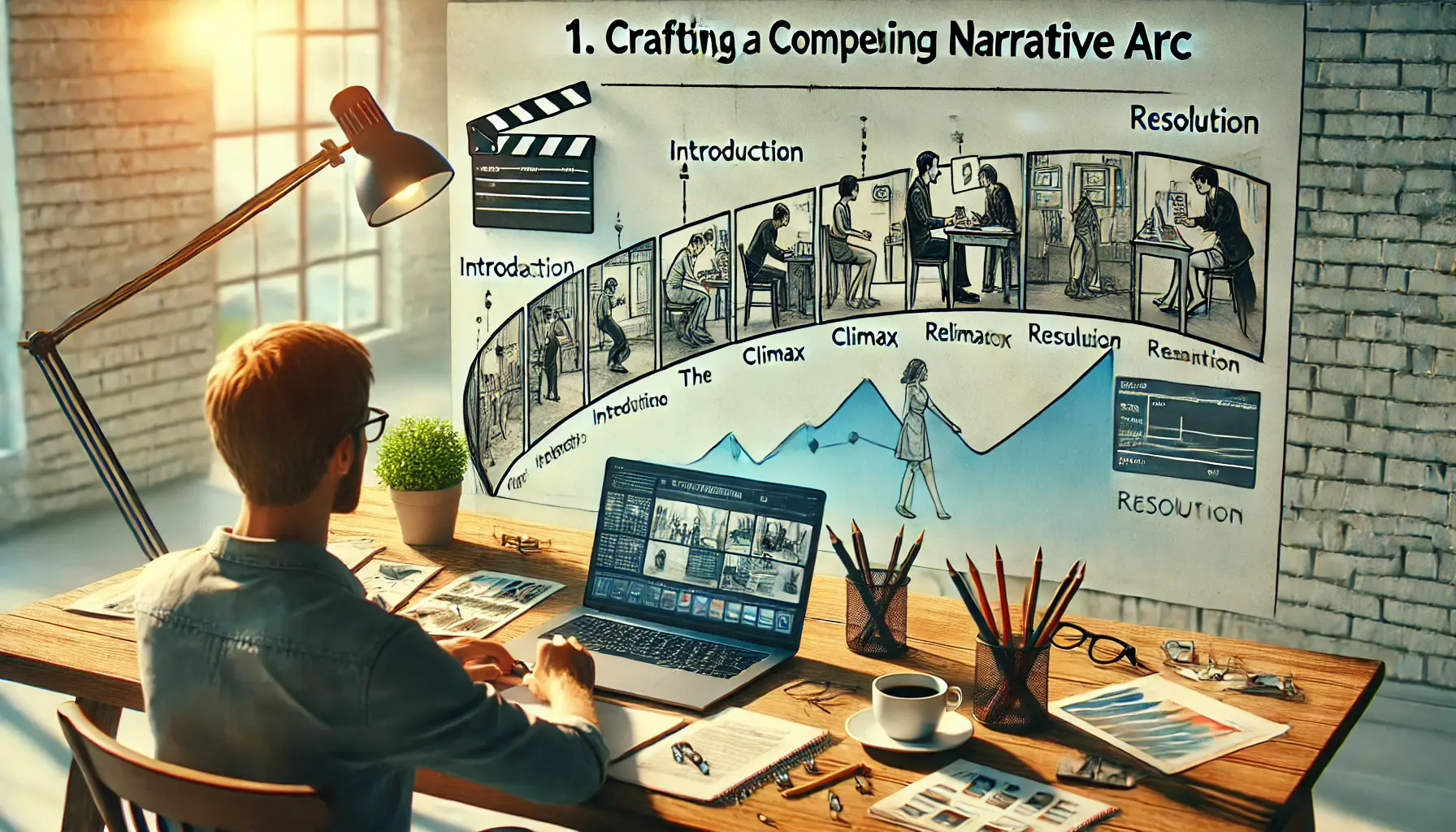
A workspace illustrating the process of crafting a compelling narrative arc for advertisements.
1. Crafting a Compelling Narrative Arc
Develop a clear beginning, middle, and end to your story.
This structure guides viewers through your message, ensuring they understand and connect with the content.
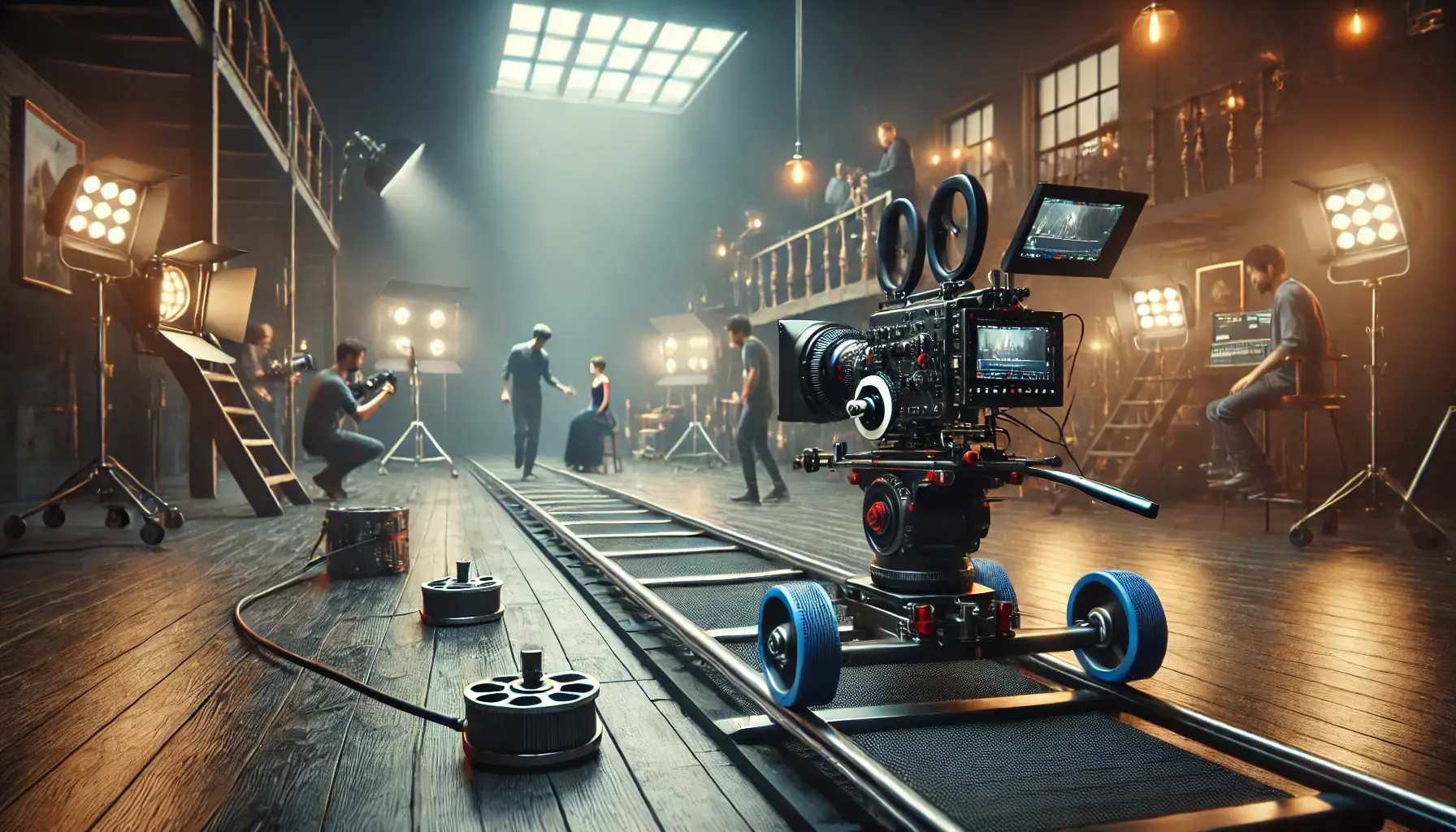
A film set highlighting the technical and creative process of using dynamic camera movements.
2. Using Dynamic Camera Movements
Pans, tilts, and zooms are camera techniques that will add energy and focus to your scenes.
Such movements can draw attention to important elements and help retain viewer interest.

A film set focusing on capturing powerful character expressions and emotions.
3. Emphasizing Character Expressions and Emotions
Show the emotions of your characters through detailed facial expressions and body language.
This helps create empathy and involvement with your audience.
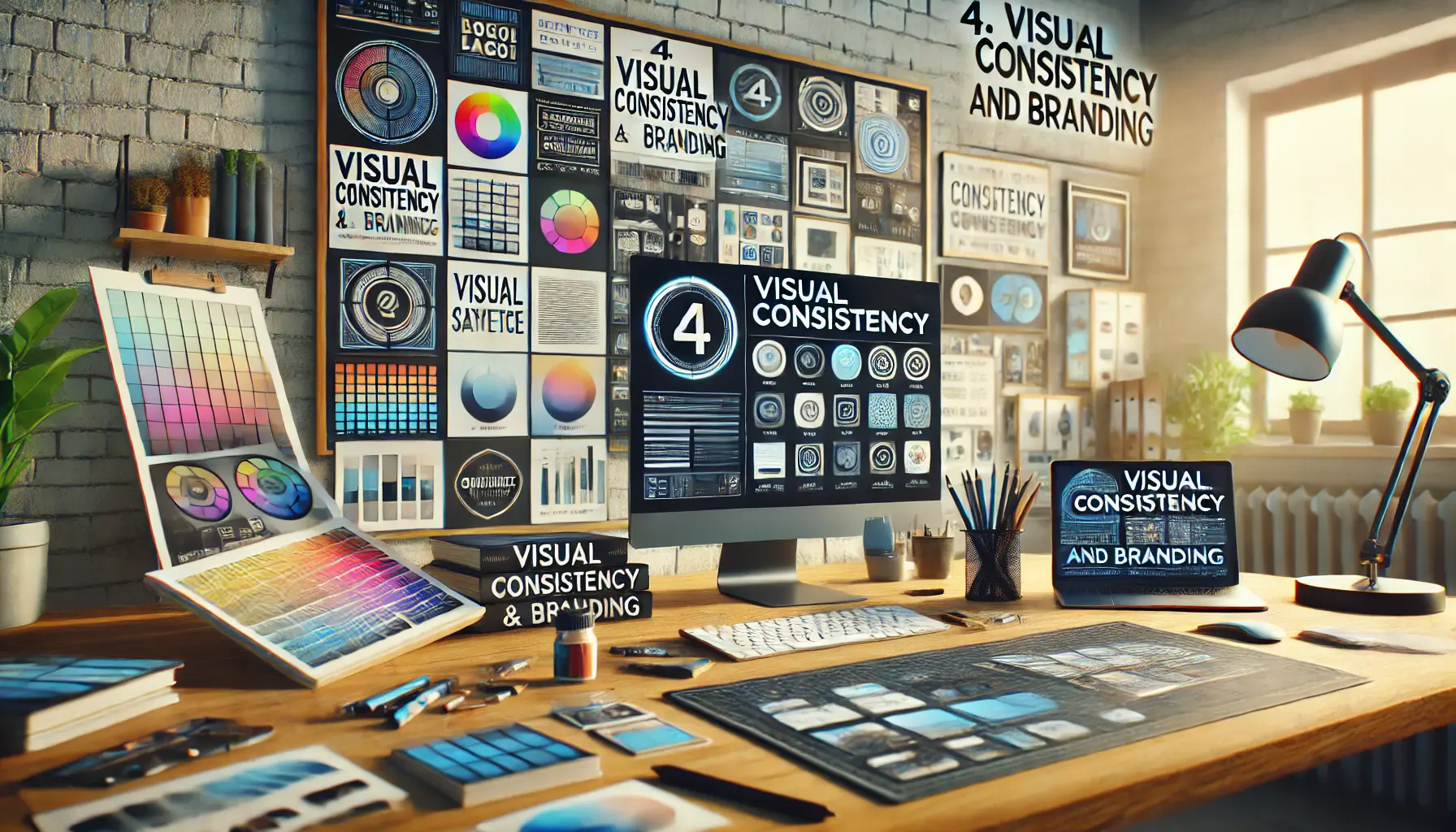
A professional workspace focusing on visual consistency and branding in advertisement creation.
4. Visual Consistency and Branding
Maintain a consistent visual style that reflects your brand’s identity.
Use specific color schemes, fonts, and imagery to reinforce brand recognition.
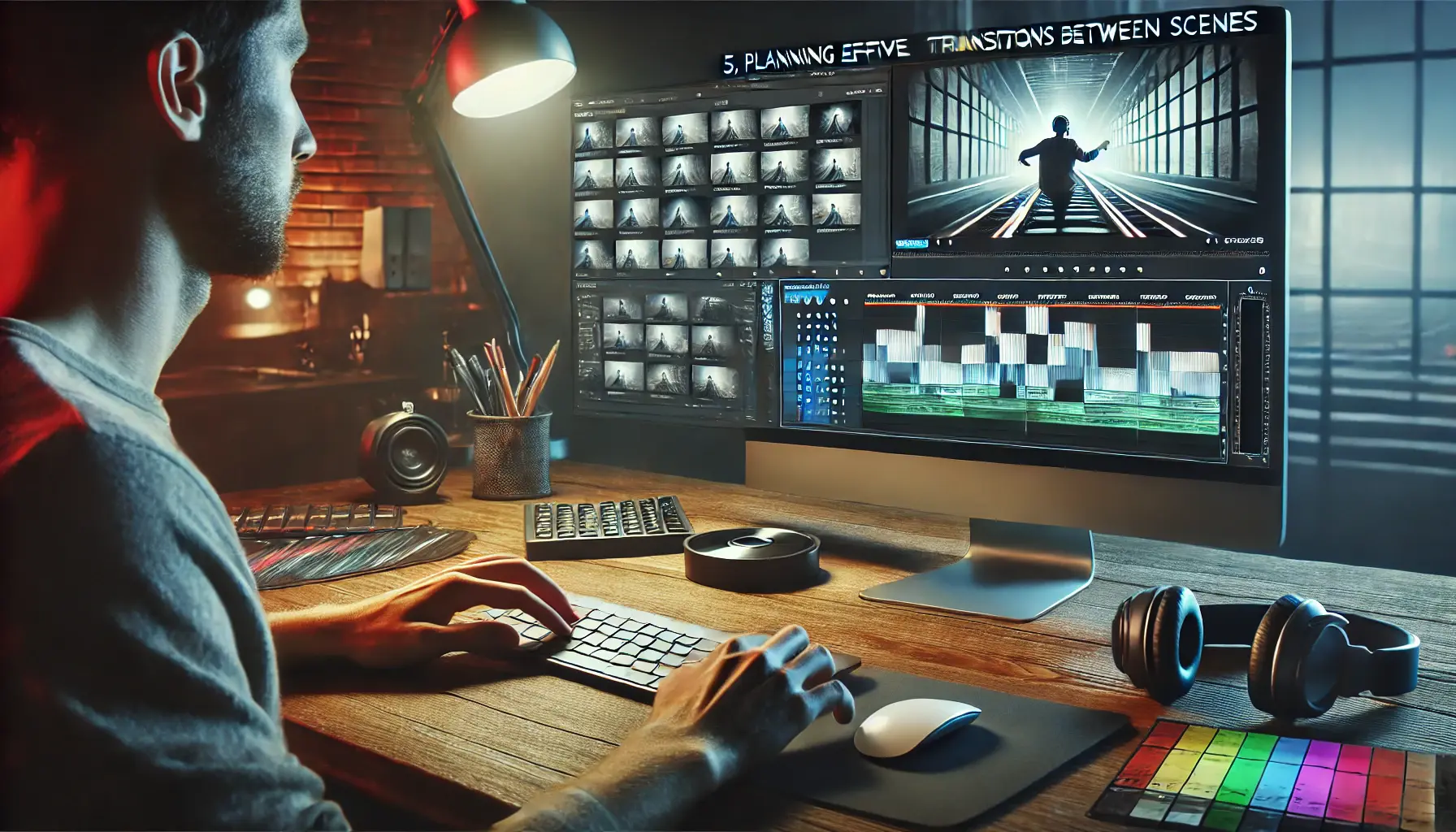
A professional workspace showing the process of planning effective transitions between scenes in video editing.
5. Planning Effective Transitions Between Scenes
Design smooth transitions to ensure a seamless flow between scenes.
Techniques like crossfadesA type of transition in which one scene gradually fades out while the next fades in, creating a smooth visual effect., wipes, or creative cuts can enhance the storytelling experience.
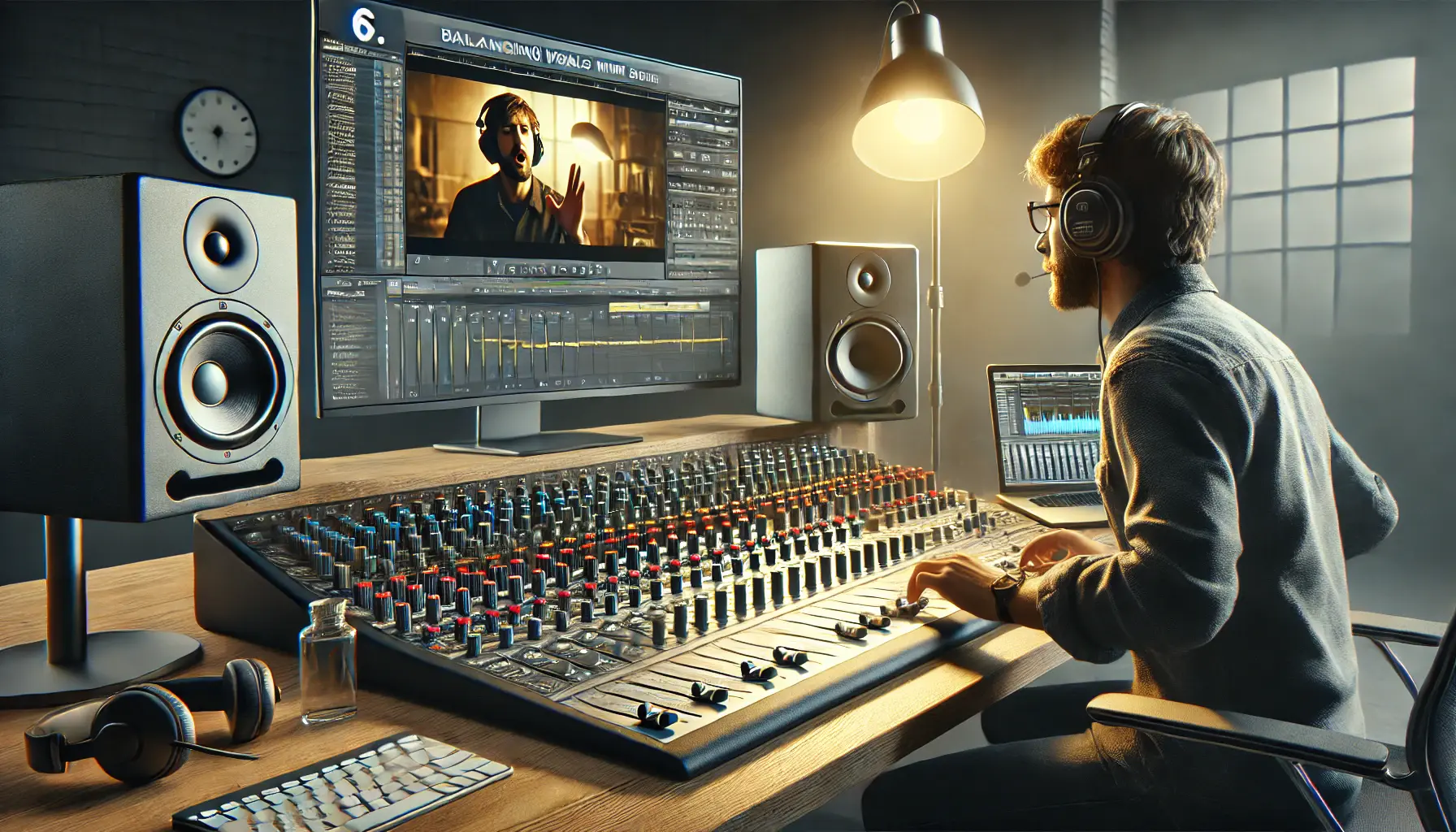
A professional sound editing workspace balancing visuals with dialogue and sound in filmmaking.
6. Balancing Visuals with Dialogue and Sound
Ensure that visuals, dialogue, and sound effects complement each other.
This balance creates a harmonious ad that effectively communicates your message.
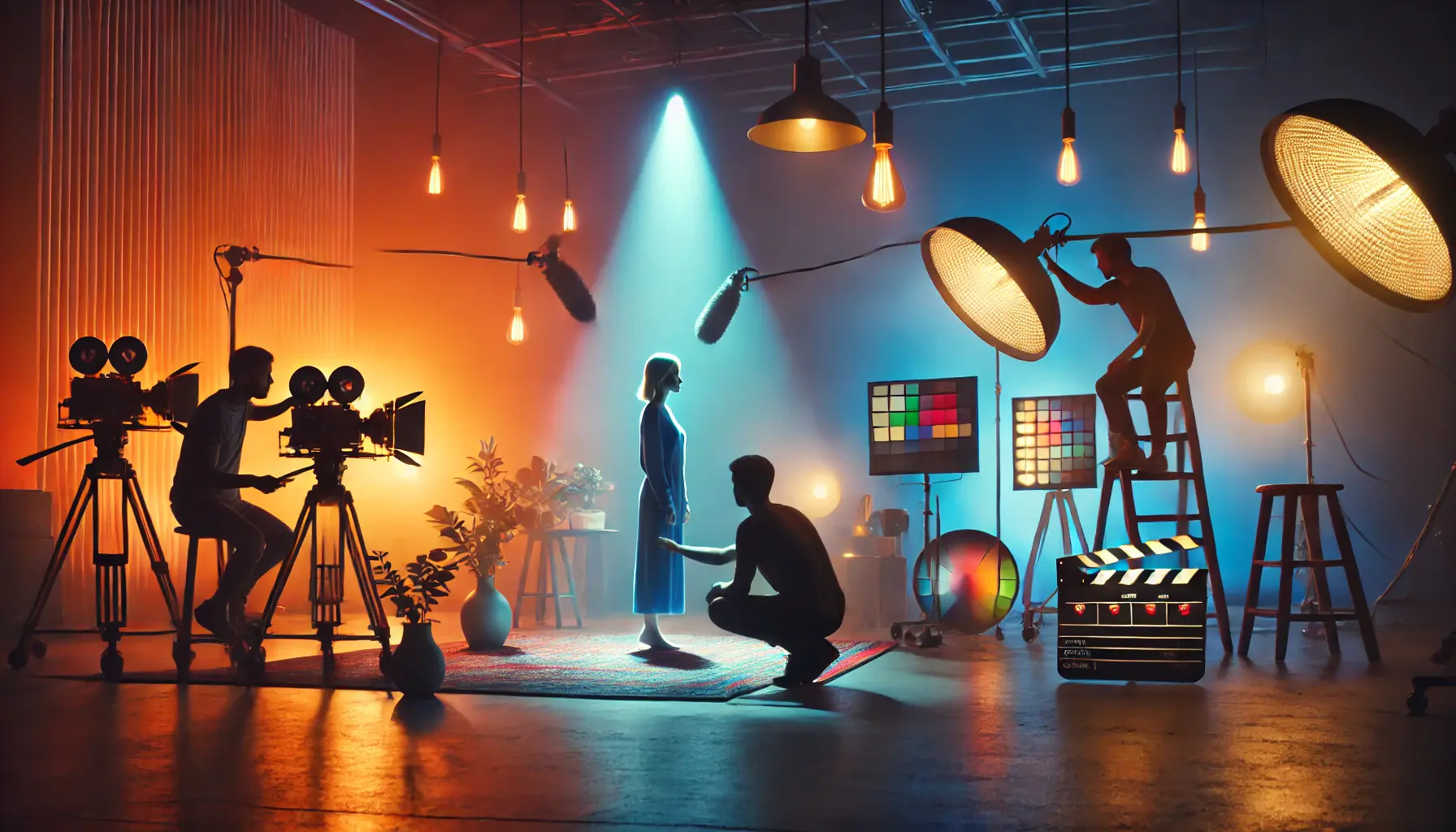
A film set showcasing the use of color and lighting to create a specific mood.
7. Using Color and Lighting to Set the Mood
Apply color theory and lighting techniques to evoke specific emotions.
Warm tones can create a sense of comfort, while cool tones may evoke calmness or professionalism.
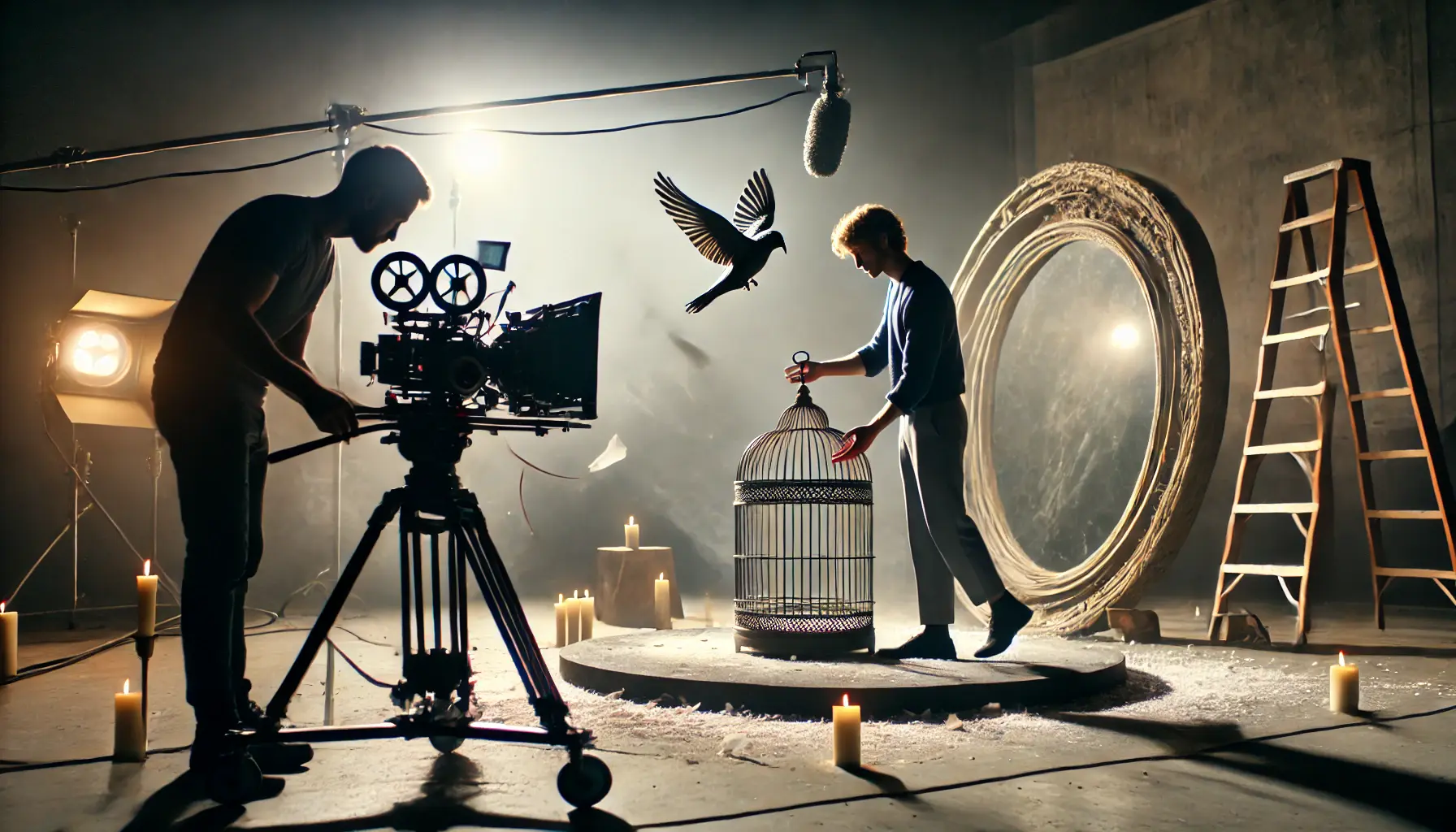
A film set showcasing the use of symbolism and metaphors in visual storytelling.
8. Implementing Symbolism and Metaphors
Incorporate symbols and metaphorsFigures of speech in which a word or phrase is applied to an object or action that is not literally applicable, used for symbolic meaning. to convey deeper meanings subtly.
This technique adds layers to your narrative, encouraging viewers to think critically about your message.
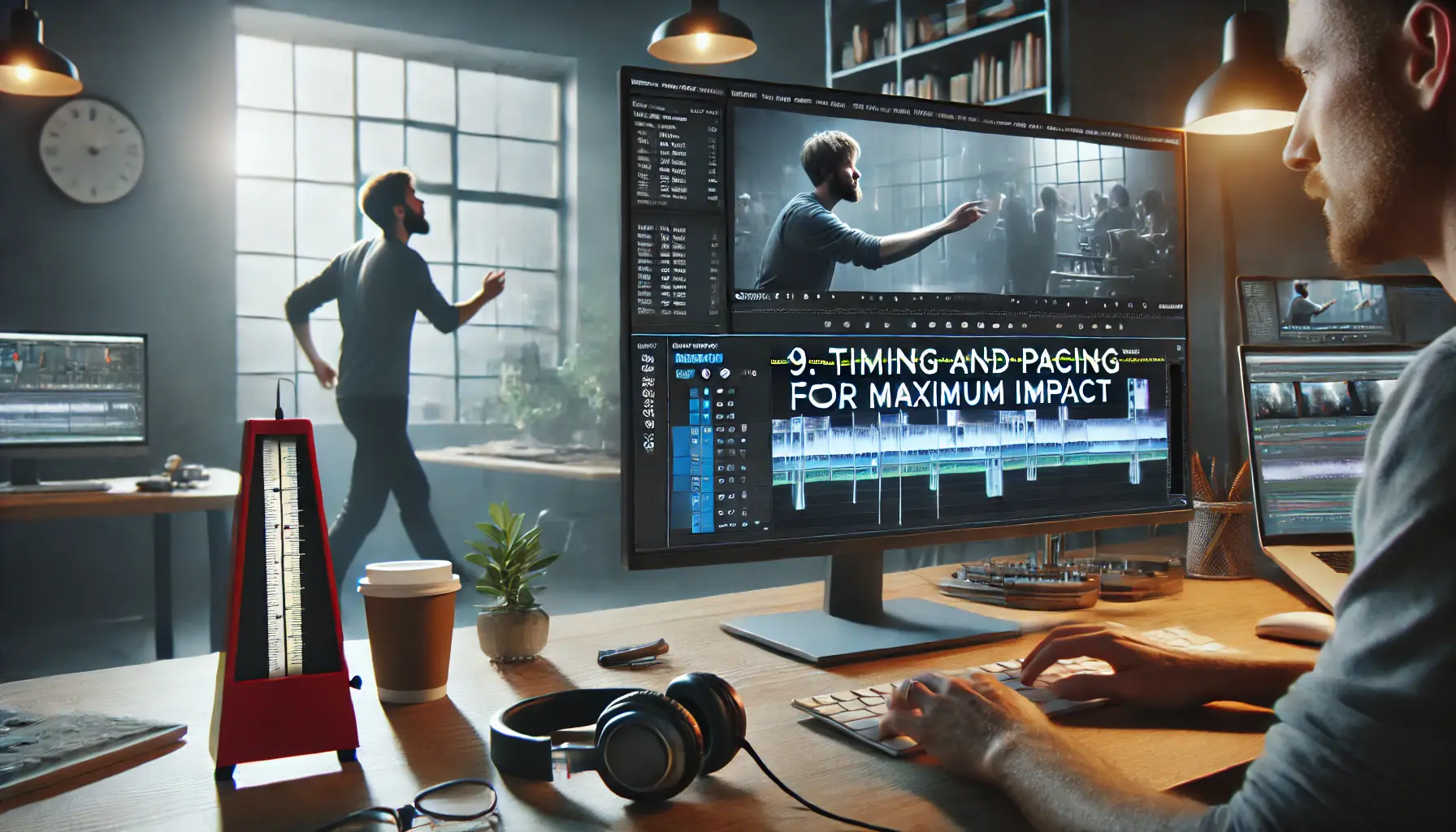
A professional workspace focusing on timing and pacing to create impactful advertisements.
9. Timing and Pacing for Maximum Impact
Control the rhythm of your advertisement by adjusting the duration of scenes and the speed of cuts.
Proper pacing keeps viewers engaged and emphasizes crucial moments.
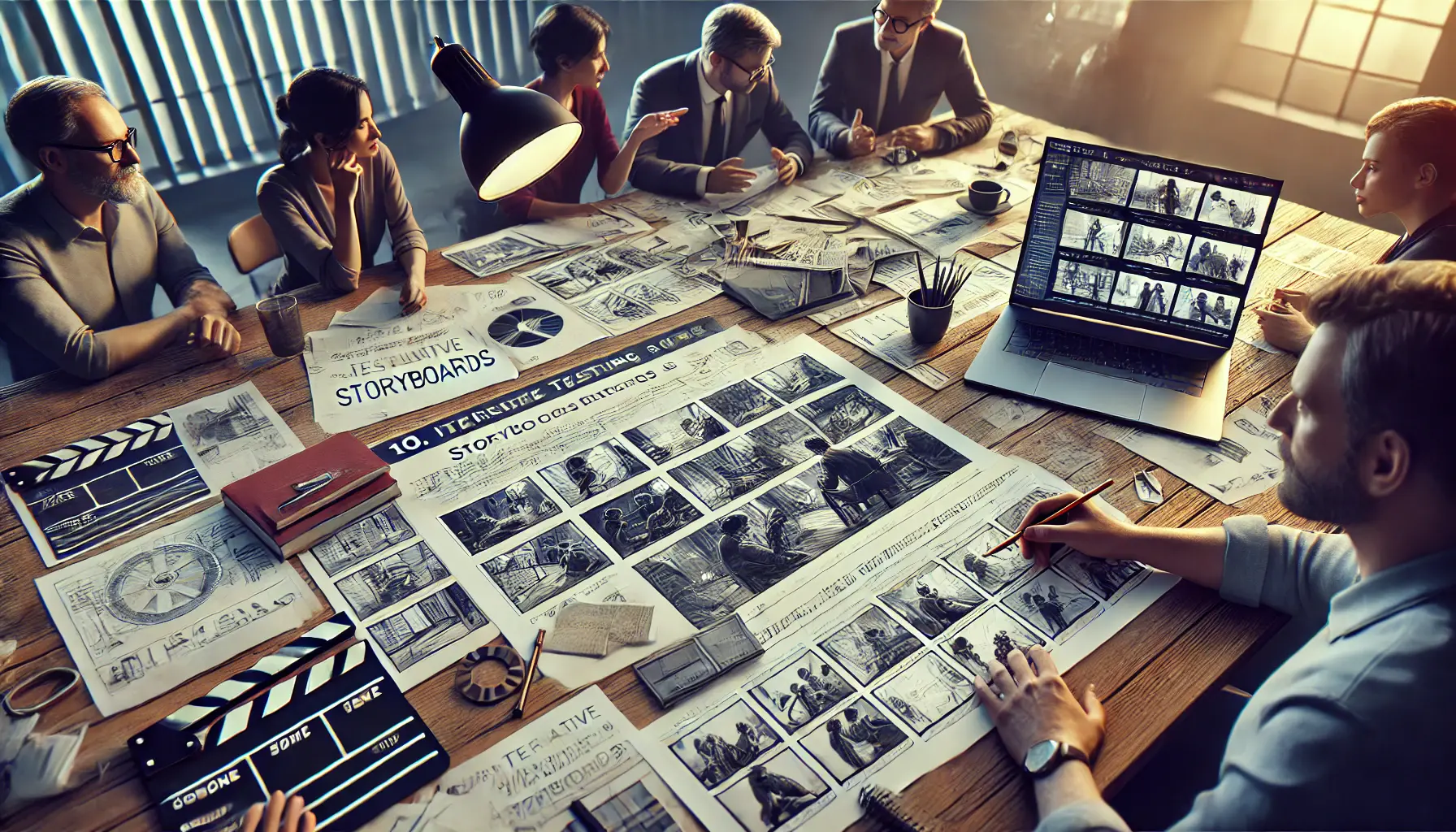
A collaborative workspace emphasizing the iterative testing and refinement process of storyboards.
10. Iterative Testing and Refinement of Storyboards
Regularly revisit and refine your storyboards in light of feedback and testing.
It’s this iteration that ensures the final advertisement resonates particularly well with the target audience.
Integrate these storyboarding techniques into your creative process, and you’ll create ads that are not only visually stunning but also emotionally impactful and memorable.
Using dynamic camera movements and emphasizing character emotions can create compelling narratives that captivate audiences.
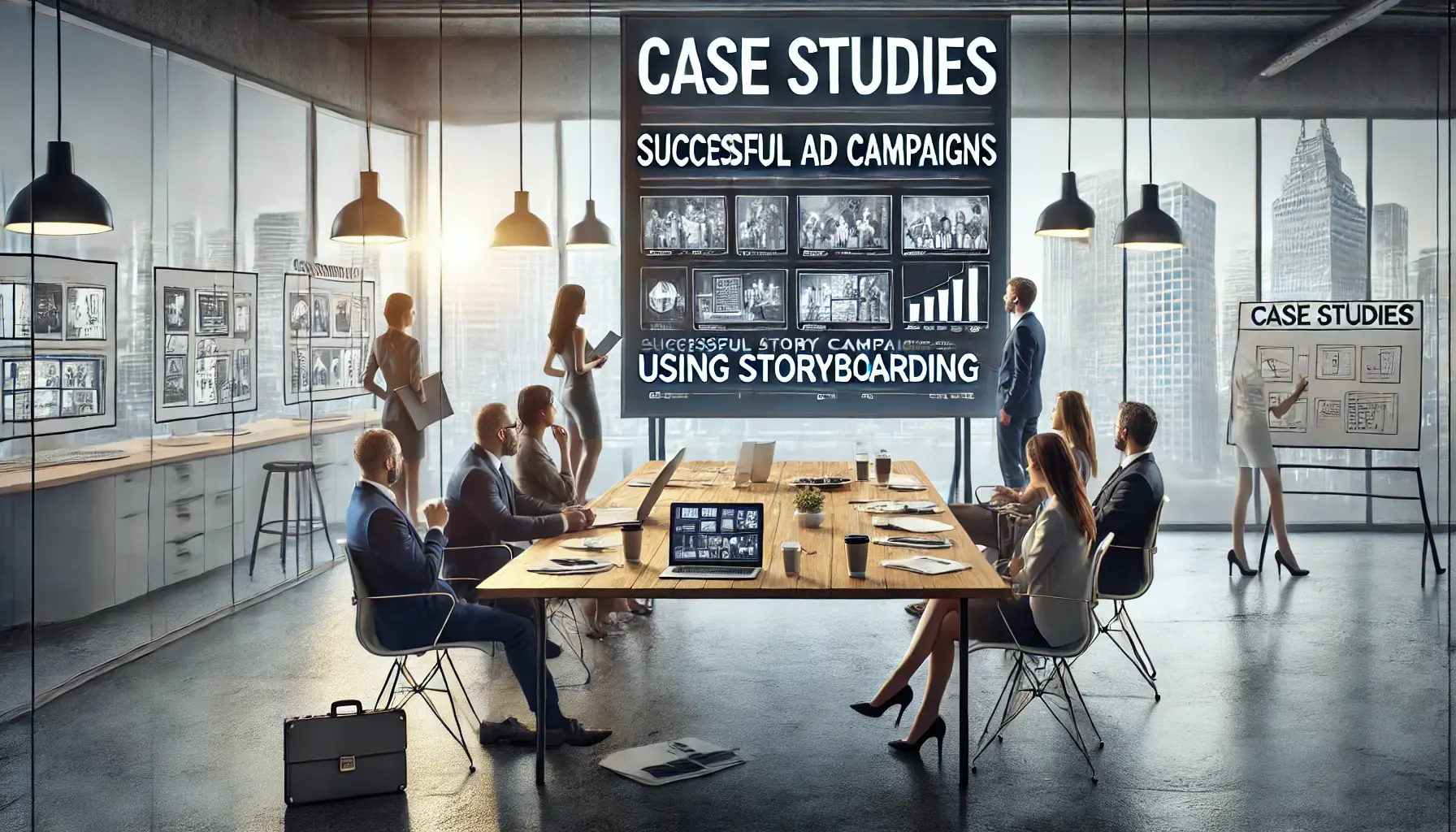
A collaborative presentation showcasing successful ad campaigns and the role of storyboarding.
Case Studies: Successful Ad Campaigns Using Storyboarding
Storyboarding has been instrumental in the success of numerous advertising campaigns, enabling brands to visualize and refine their narratives before production.
Let’s explore some notable examples where effective storyboarding techniques played a pivotal role.
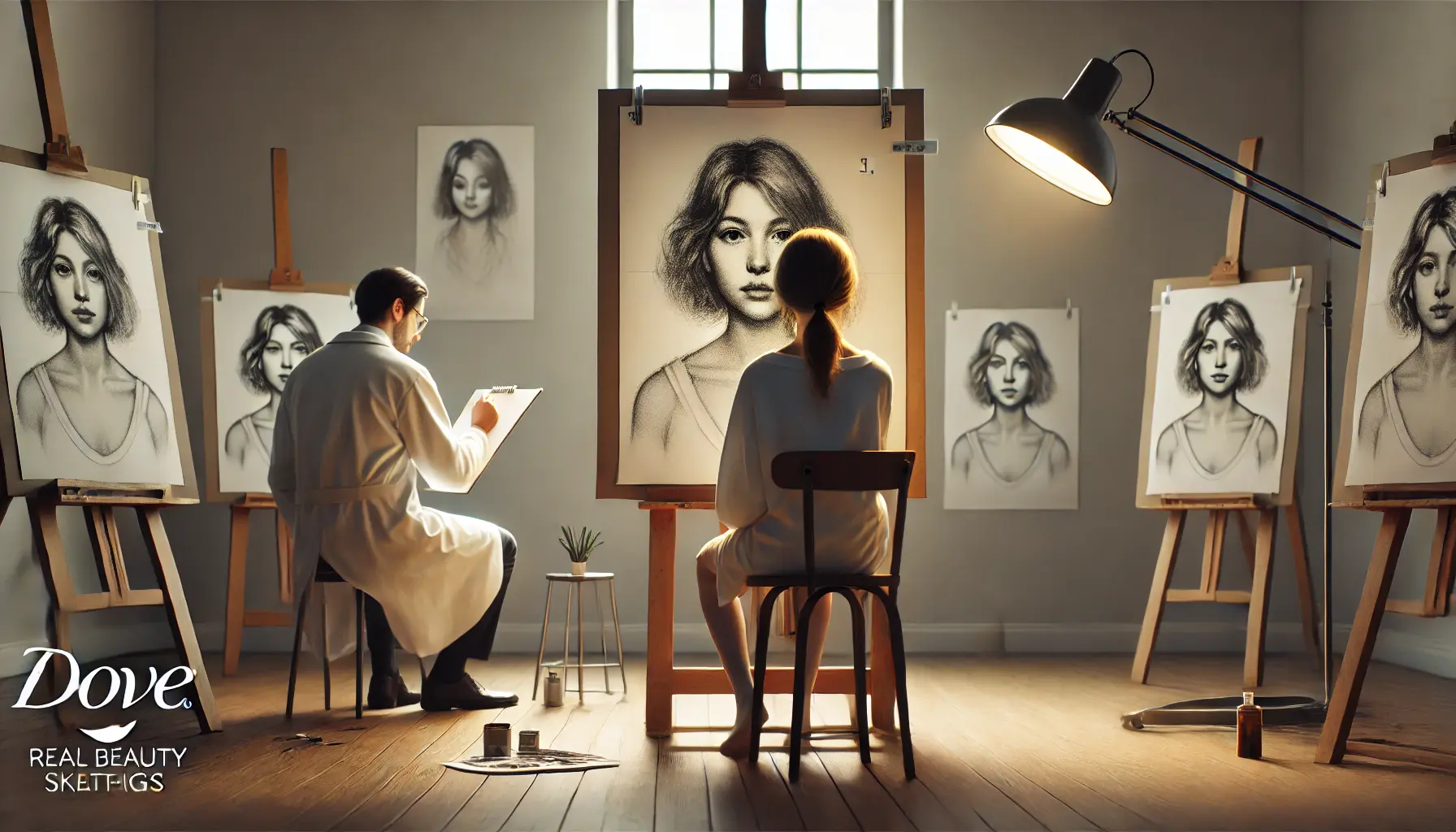
A scene reflecting Dove’s ‘Real Beauty Sketches’ campaign, showcasing the contrast in self-perception versus how others see us.
1. Dove’s ‘Real Beauty Sketches’ Campaign
Dove’s ‘Real Beauty Sketches’ campaign aimed to challenge societal beauty standards by illustrating the disparity between self-perception and how others perceive us.
Through meticulous storyboarding techniques, the campaign depicted real women describing themselves to a forensic sketch artist, followed by strangers providing descriptions of the same women.
The contrasting sketches highlighted the often harsh self-critique individuals have, reinforcing Dove’s message of embracing one’s natural beauty.
This campaign resonated deeply with audiences, garnering over 114 million views in its first month and significantly boosting brand engagement.
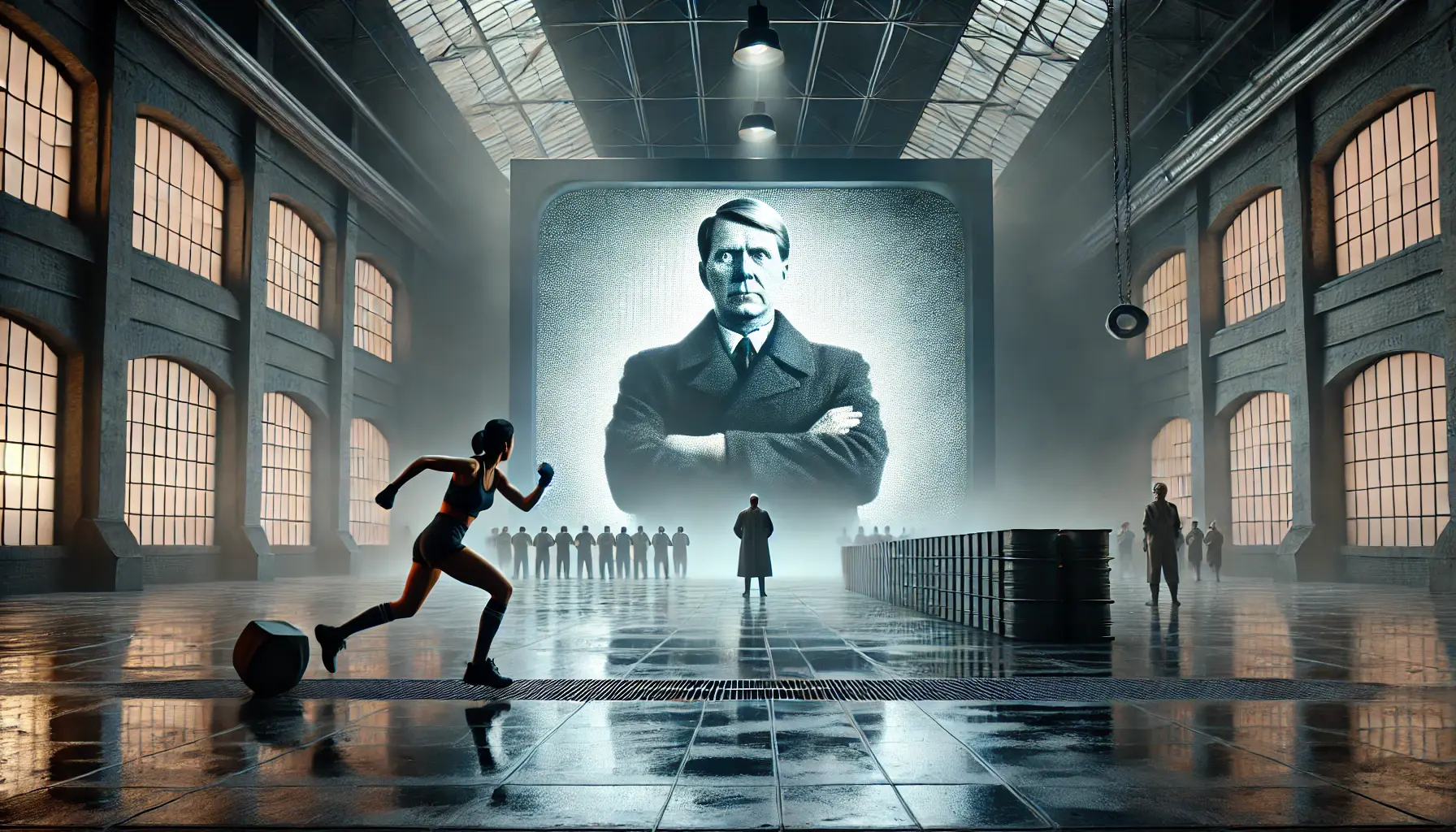
A dramatic representation of Apple’s ‘1984’ Super Bowl commercial, highlighting the revolutionary moment of defiance against authority.
2. Apple’s ‘1984’ Super Bowl Commercial
Apple’s iconic ad ‘1984’, which launched the Macintosh, is a testament to how storyboarding techniques helped compose a commercial with a punch.
The storyboard meticulously outlined the details of a dystopianRelating to an imagined state or society where there is great suffering or injustice, often used in storytelling. scenario inspired by George Orwell’s book, down to the climactic moment when a heroine destroyed a screen depicting ‘Big Brother’ and disrupted conformity.
This visual tale positioned Apple as a revolutionary force in computing.
The commercial’s precise execution, guided by detailed storyboards, left an indelible mark on viewers and is still celebrated as one of the most influential ads in history.

A visual representation of the quirky and dynamic elements in Old Spice’s ‘The Man Your Man Could Smell Like’ campaign.
3. Old Spice’s ‘The Man Your Man Could Smell Like’ Campaign
Old Spice revitalized its brand with the hilarious ‘The Man Your Man Could Smell Like’ campaign.
The ad was filled with fast scene cuts and quick-witted monologues choreographed through detailed storyboarding techniques.
By taking the time to carefully storyboard every shot, the creative team ensured the scenes were seamlessly connected and told a coherent story for viewers.
The results were undeniable: the campaign achieved a 125% increase in sales and more than 70 million YouTube views, proving that efficient storyboarding reaps significant rewards in the advertising industry.
These case studies highlight the importance of storyboarding techniques in creating effective advertisements.
By conceptualizing every element in advance, brands can develop coherent and engaging stories that resonate with audiences and drive success.
Dove’s ‘Real Beauty Sketches’ and Apple’s ‘1984’ illustrate the transformative power of meticulous storyboarding in ad success.
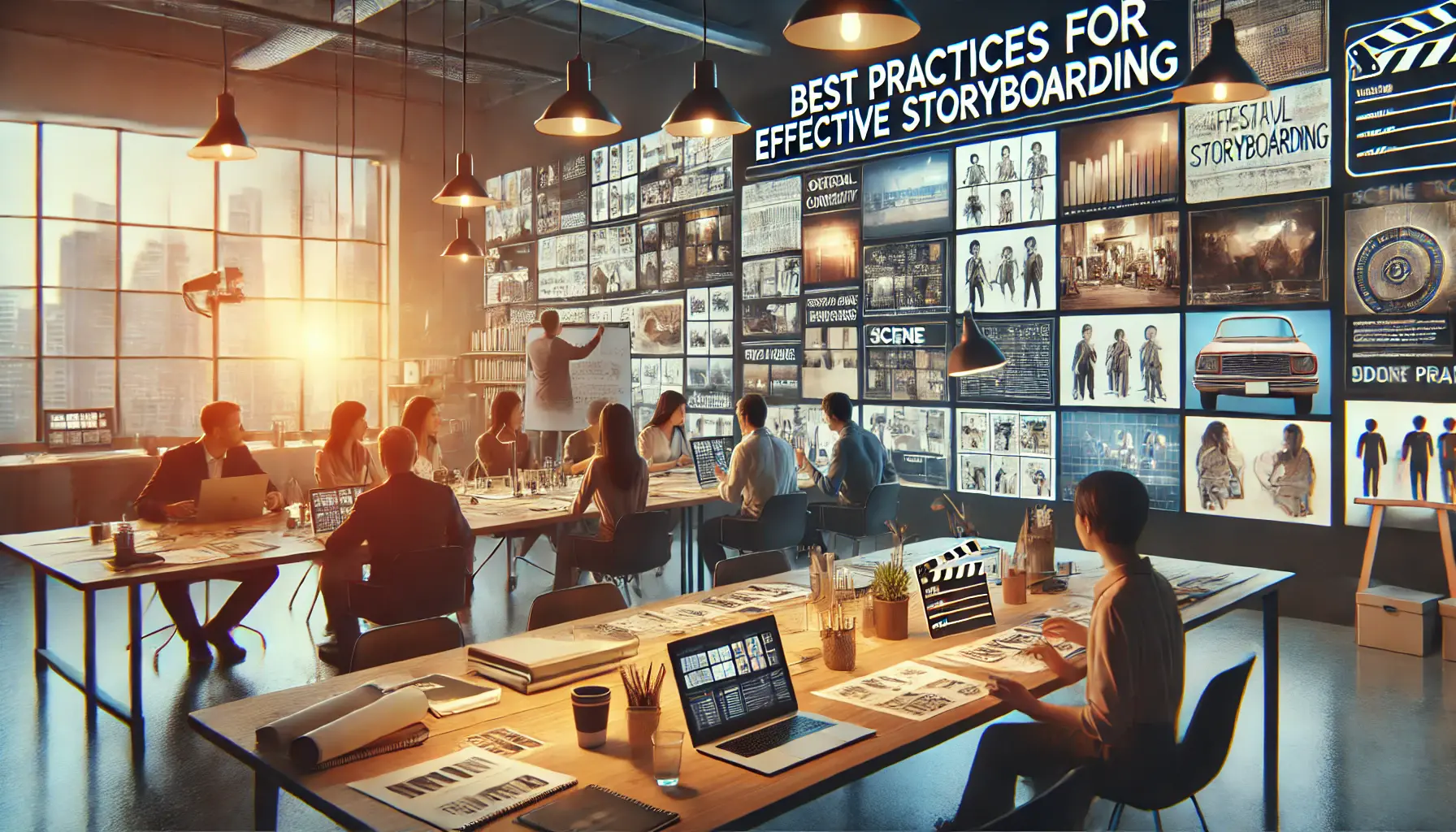
A professional and collaborative workspace focusing on best practices for effective storyboarding in advertising.
Best Practices for Effective Storyboarding in Advertising
Implementing effective storyboarding techniques is crucial for creating compelling advertisements that resonate with your target audience.
By following these best practices, you can enhance your creative process and produce impactful marketing content.
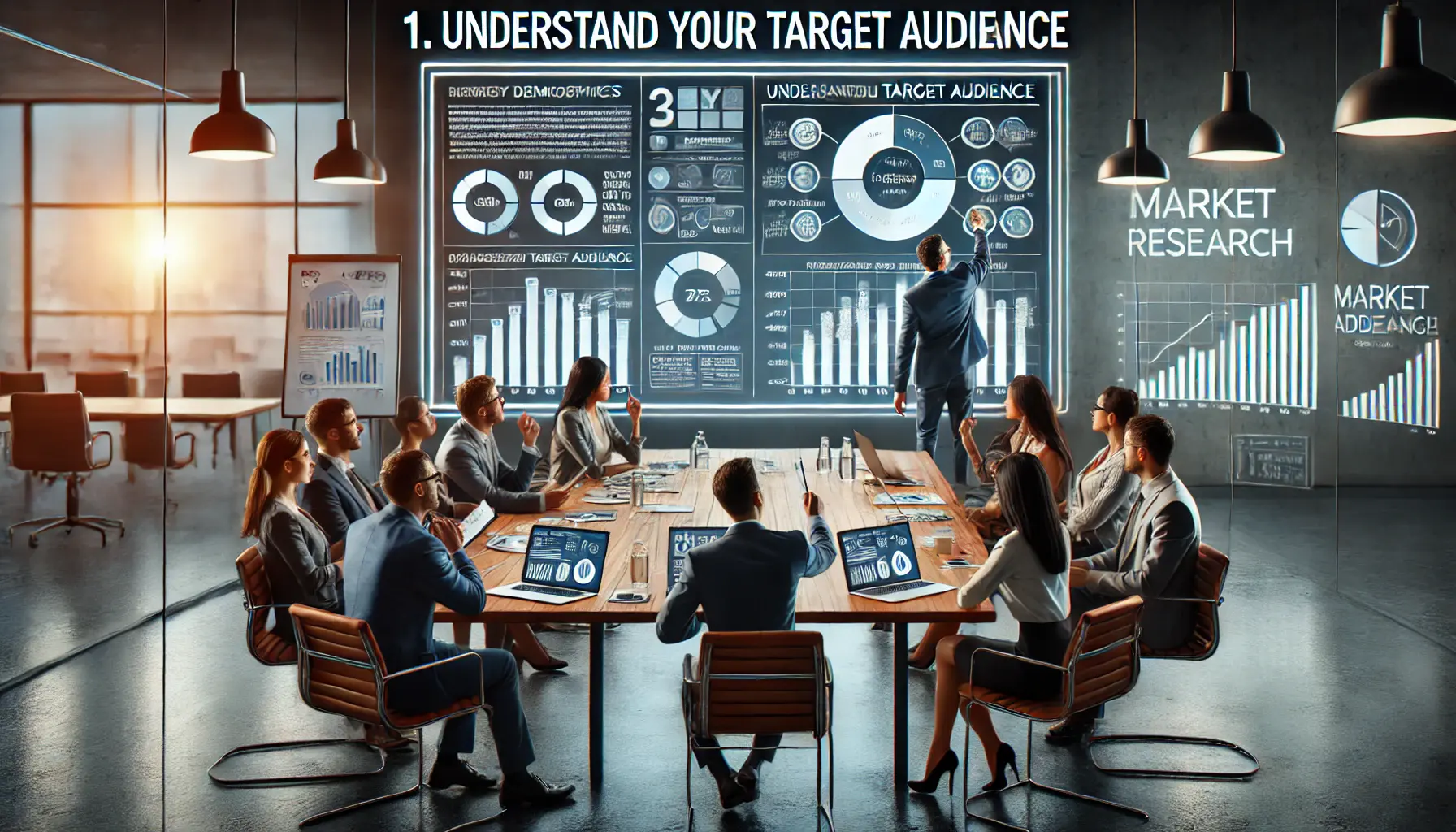
A focused marketing team discussing strategies based on target audience insights for effective advertising.
1. Understand Your Target Audience
Before you begin storyboarding, it’s essential to have a clear understanding of your target audience.
Consider their demographics, preferences, and pain points.
This knowledge will guide your narrative and ensure your advertisement speaks directly to those you aim to reach.
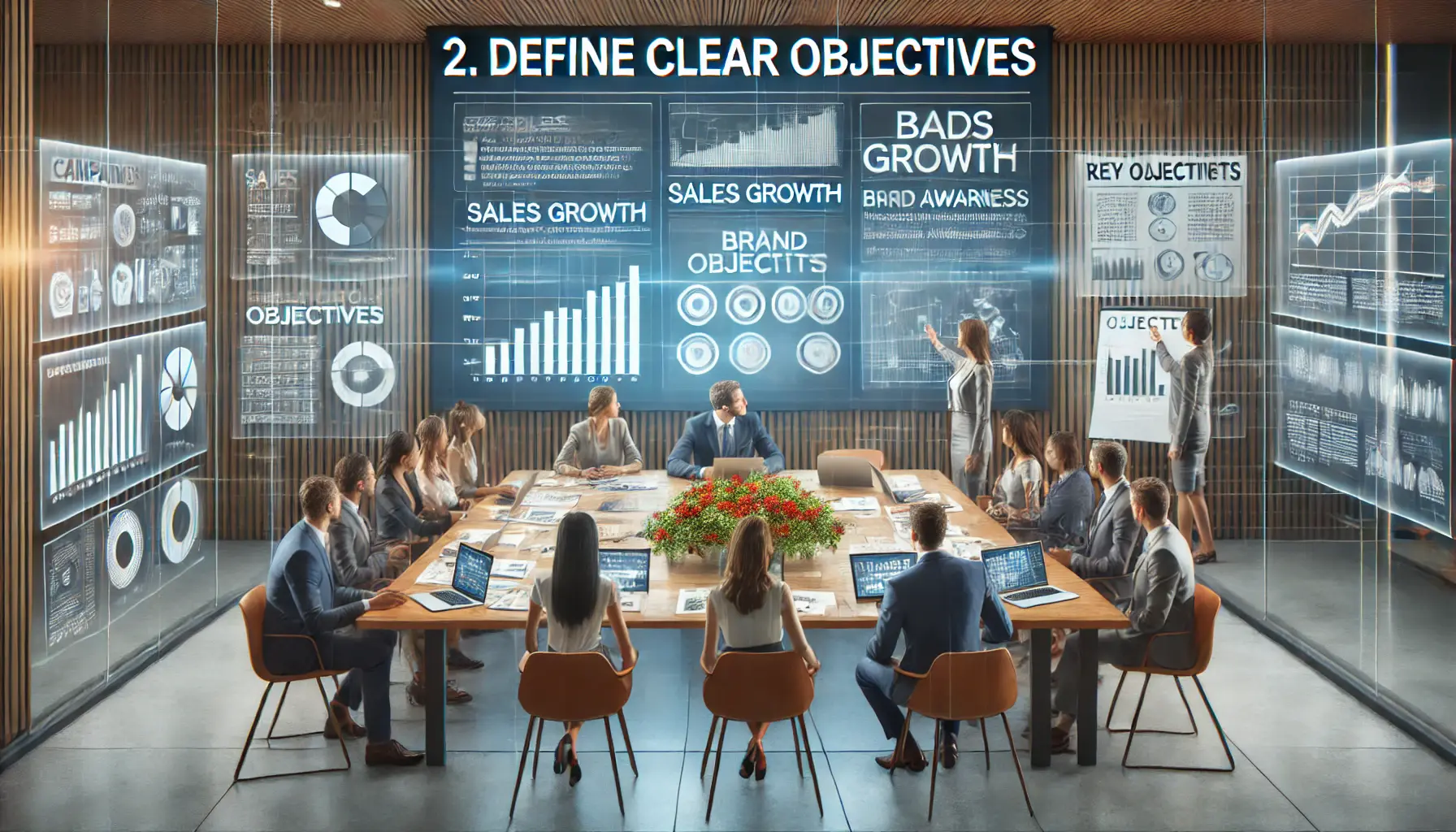
A professional meeting where a marketing team defines clear objectives for a campaign.
2. Define Clear Objectives
Establish the primary goals of your advertisement.
Whether it’s increasing brand awareness, driving sales, or promoting a new product, clear objectives will shape your storyboard’s direction and messaging.
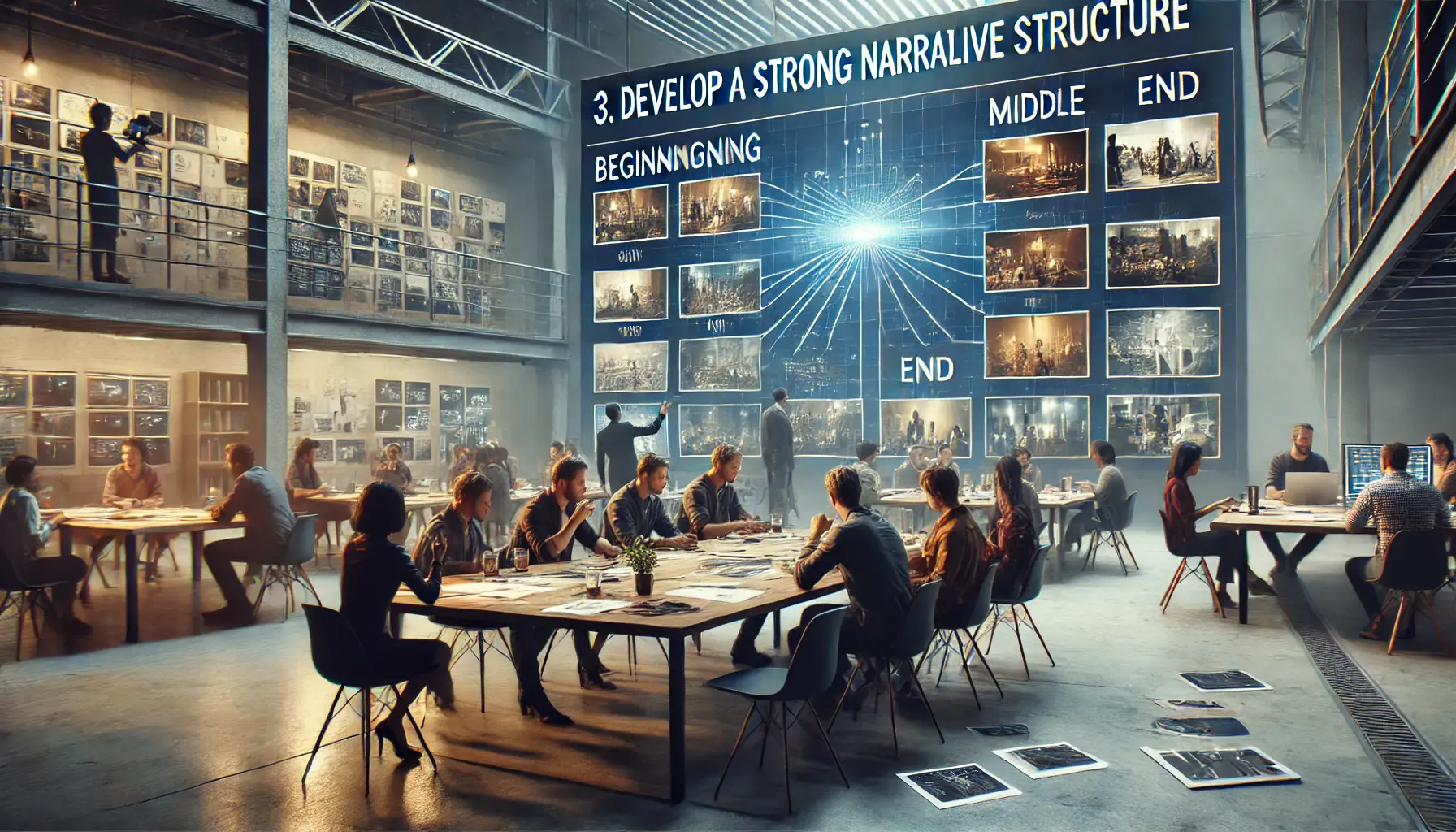
A collaborative workspace focusing on developing a strong narrative structure for a story.
3. Develop a Strong Narrative Structure
Craft a compelling story with a clear beginning, middle, and end.
A well-structured narrative engages viewers and conveys your message effectively.
Consider incorporating elements that evoke emotions, as emotional connections can significantly impact consumer behavior.

A collaborative and interactive meeting where a creative team works together to refine ideas and strategies.
4. Collaborate with Your Team
Involve key stakeholders in the storyboarding process.
Collaboration fosters diverse ideas and perspectives, leading to a more refined and effective advertisement.
Utilize feedback to make necessary adjustments and improvements.
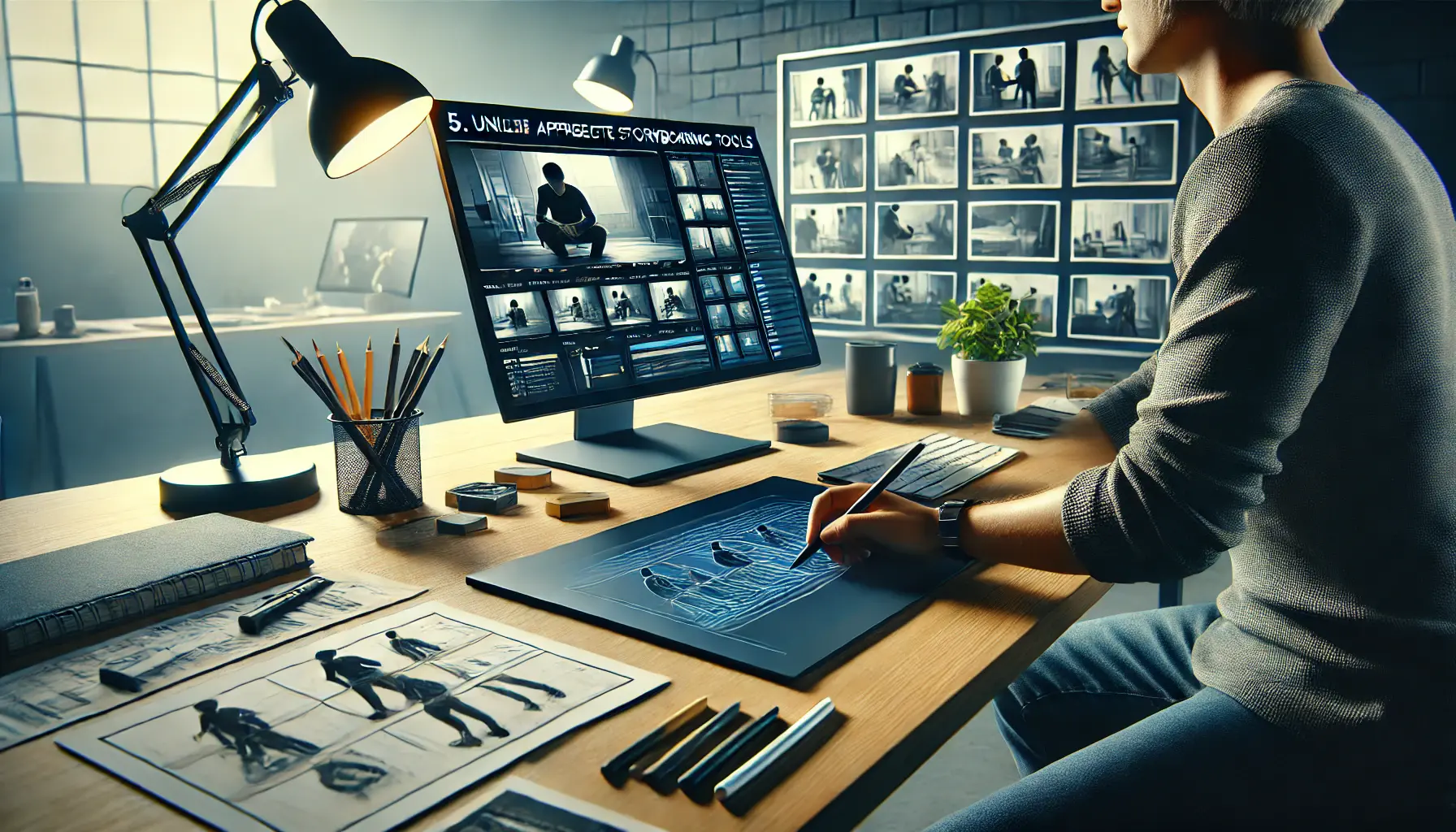
A modern workspace showcasing the use of both digital and traditional tools for effective storyboarding.
5. Utilize Appropriate Storyboarding Tools
Leverage digital storyboarding software to streamline the process.
Here are some popular tools:
- Storyboarder by Wonder Unit: A free, open-source tool suitable for quick sketches and detailed boards.
- Toon Boom Storyboard Pro: An industry-standard software offering advanced features for professional storyboarding.
- Boords: A user-friendly, web-based platform ideal for collaborative storyboarding.
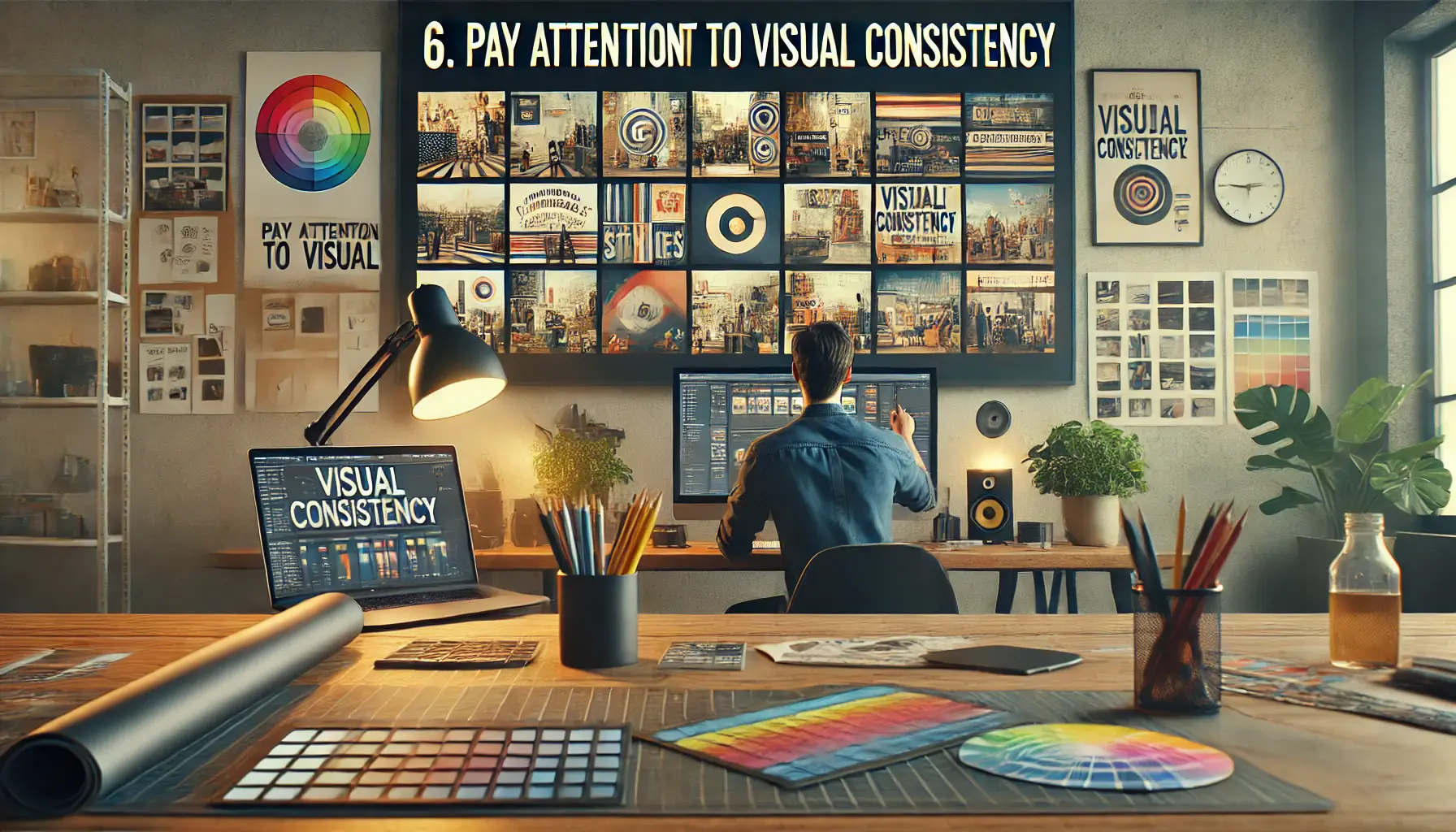
A professional workspace focused on ensuring visual consistency across storyboard frames.
6. Pay Attention to Visual Consistency
Ensure that visual elements such as color schemes, fonts, and imagery align with your brand identity.
Consistency reinforces brand recognition and conveys professionalism.
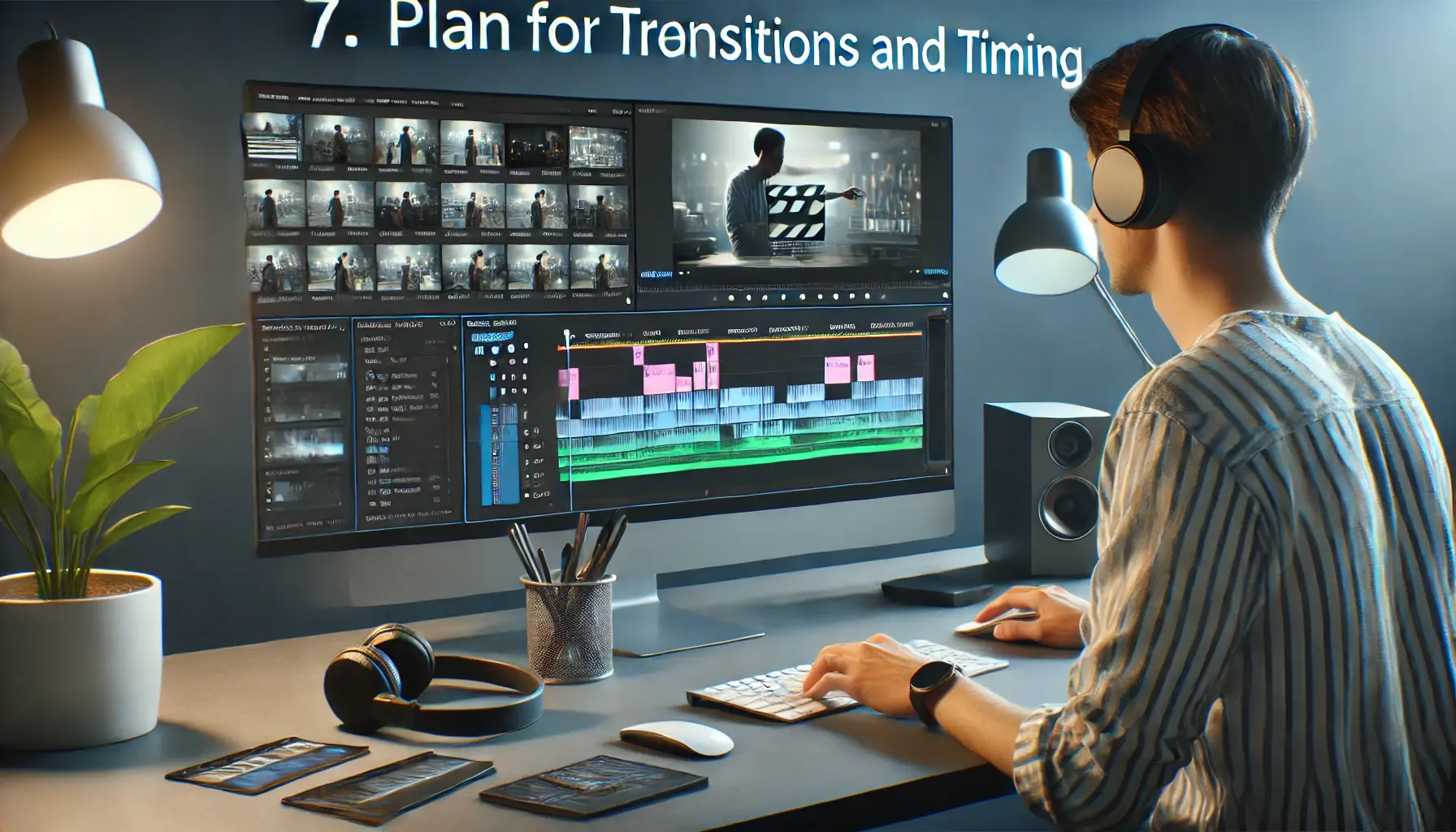
A professional film editing workspace focused on planning transitions and timing for smooth scene changes.
7. Plan for Transitions and Timing
Detail how each scene transitions to the next and allocate appropriate timing for each segment.
Smooth transitions and well-paced timing contribute to a cohesive and engaging advertisement.
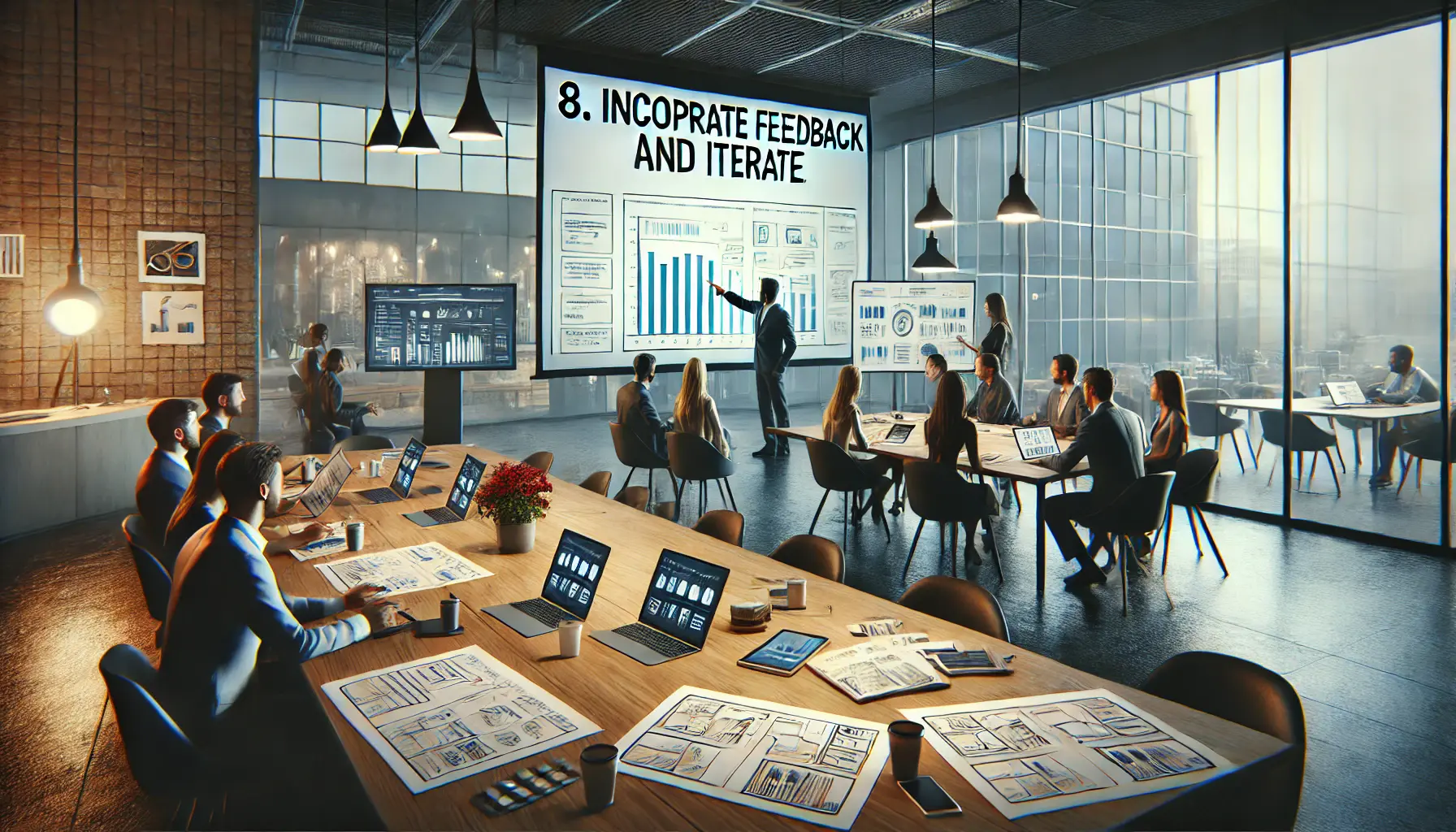
A collaborative meeting where a team incorporates feedback and iterates on a storyboard to refine the creative process.
8. Incorporate Feedback and Iterate
Review your storyboard with team members and stakeholders, gathering constructive feedback.
Be prepared to make revisions to enhance the overall effectiveness of your advertisement.
By following these best practices and using efficient storyboarding techniques, you’ll be able to create advertisements that are not only visually stunning but also strategically aligned with your marketing goals.
Failing to incorporate feedback and refine your storyboard can lead to missed opportunities for improvement.
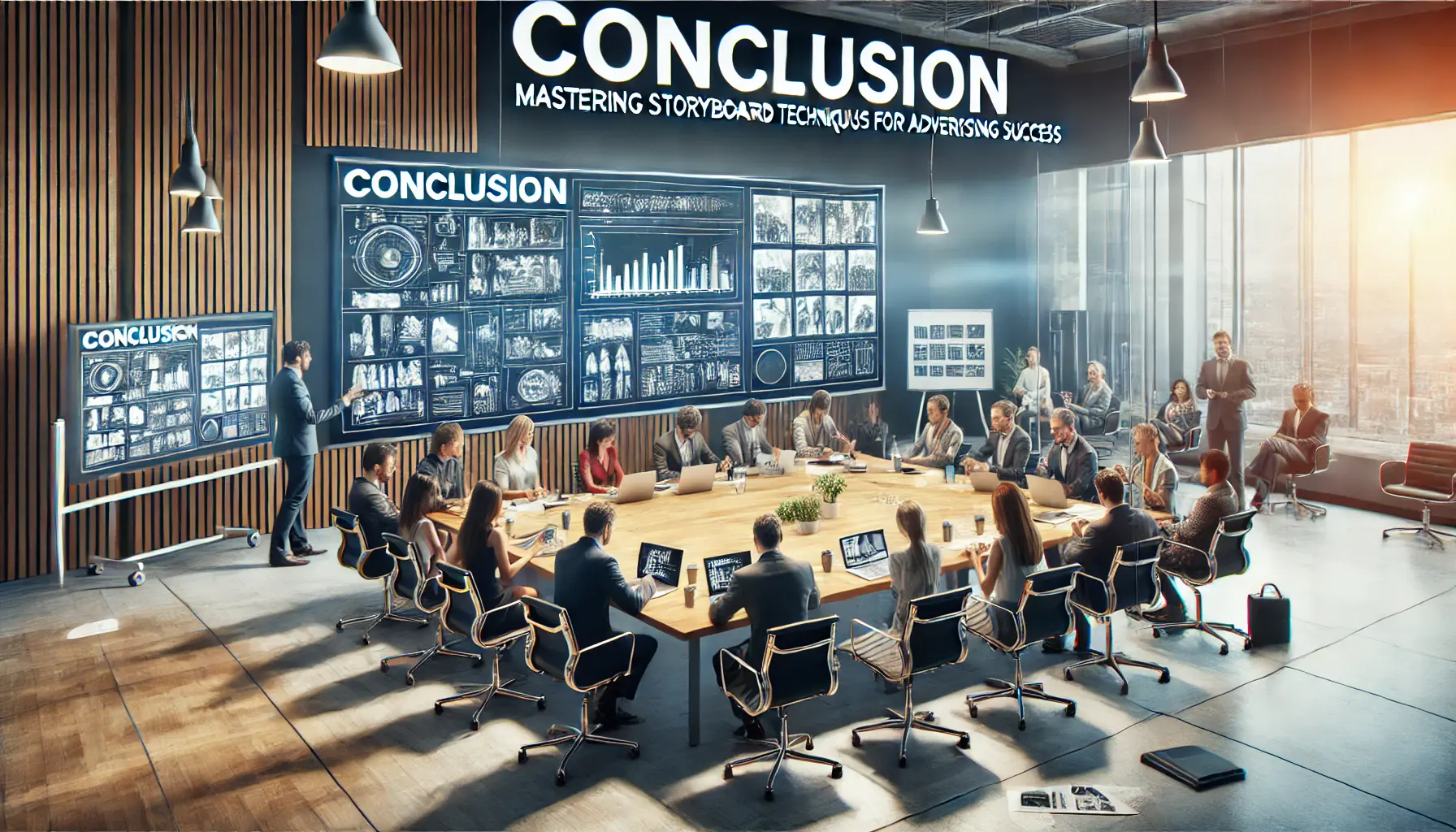
A professional team collaborating on the finalization of a storyboard to ensure advertising success.
Conclusion: Mastering Storyboarding Techniques for Advertising Success
Storyboarding is an indispensable tool for crafting compelling advertisements.
By visualizing your narrative and meticulously planning each scene, you set the foundation for creative, engaging, and effective campaigns.
Throughout this article, we have explored the importance of storyboarding, essential elements, top techniques, inspiring case studies, and best practices to elevate your advertising efforts.
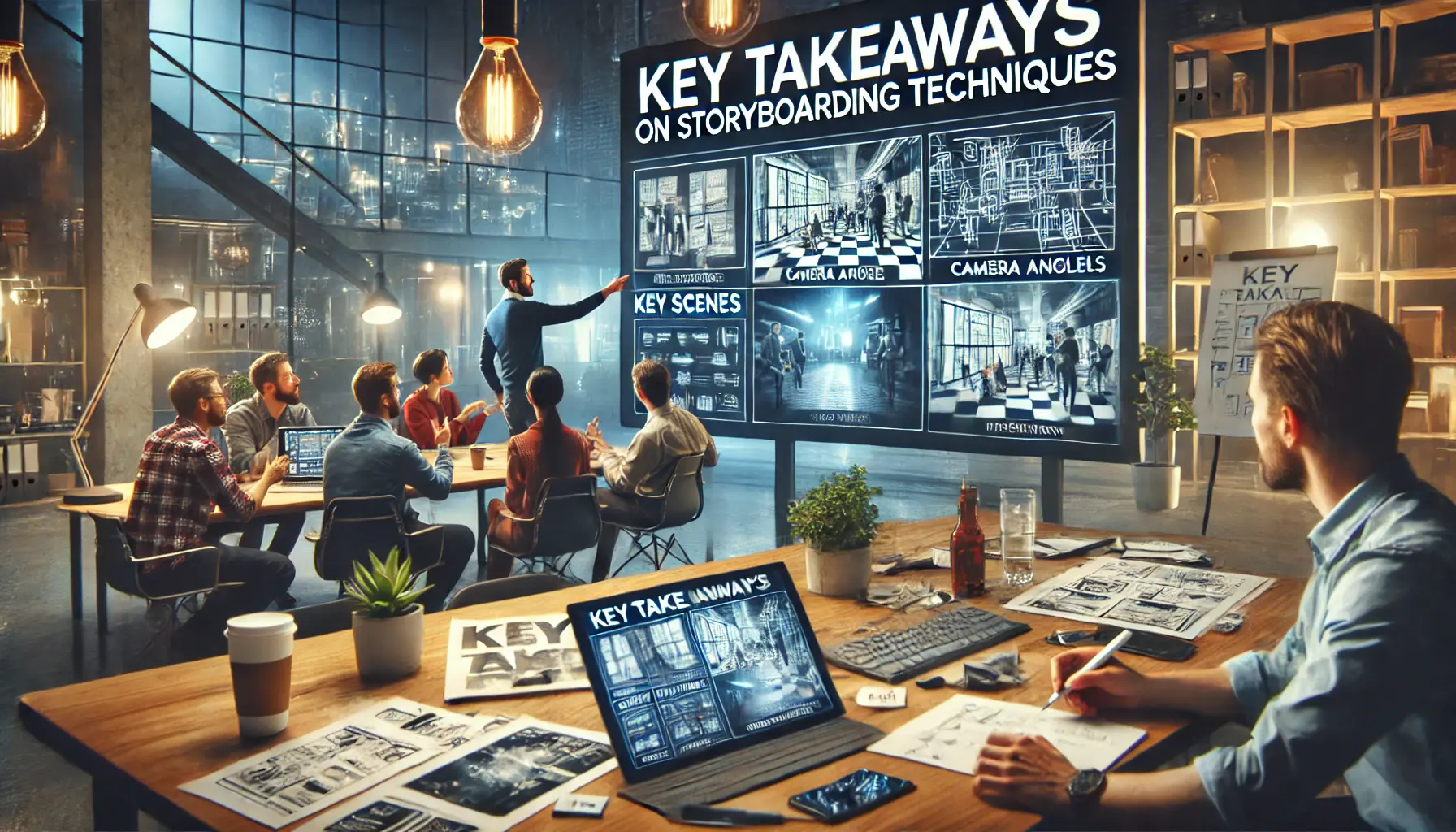
A team engaged in reviewing and discussing the key takeaways from storyboarding techniques for effective advertising.
Key Takeaways on Storyboarding Techniques
- Visualizing the Narrative: Storyboarding enables you to map your ad’s progress, ensuring cohesion and an interesting storyline within your ad.
- What to Include: A storyboard should consist of visual frames, scene descriptions, dialogue exchange, and transitions between scenes or frames for complete clarity and professionalism.
- Top Techniques: Dynamic use of the camera, branding continuity, and emotional storytelling are techniques most likely to connect with audiences.
- Learning from Case Studies: Iconic campaigns like Dove’s ‘Real Beauty Sketches’ and Apple’s ‘1984’ demonstrate the transformative power of effective storyboarding.
- Best Practices: Understand your audience, collaborate with your team, and iterate based on feedback to refine your final storyboard.
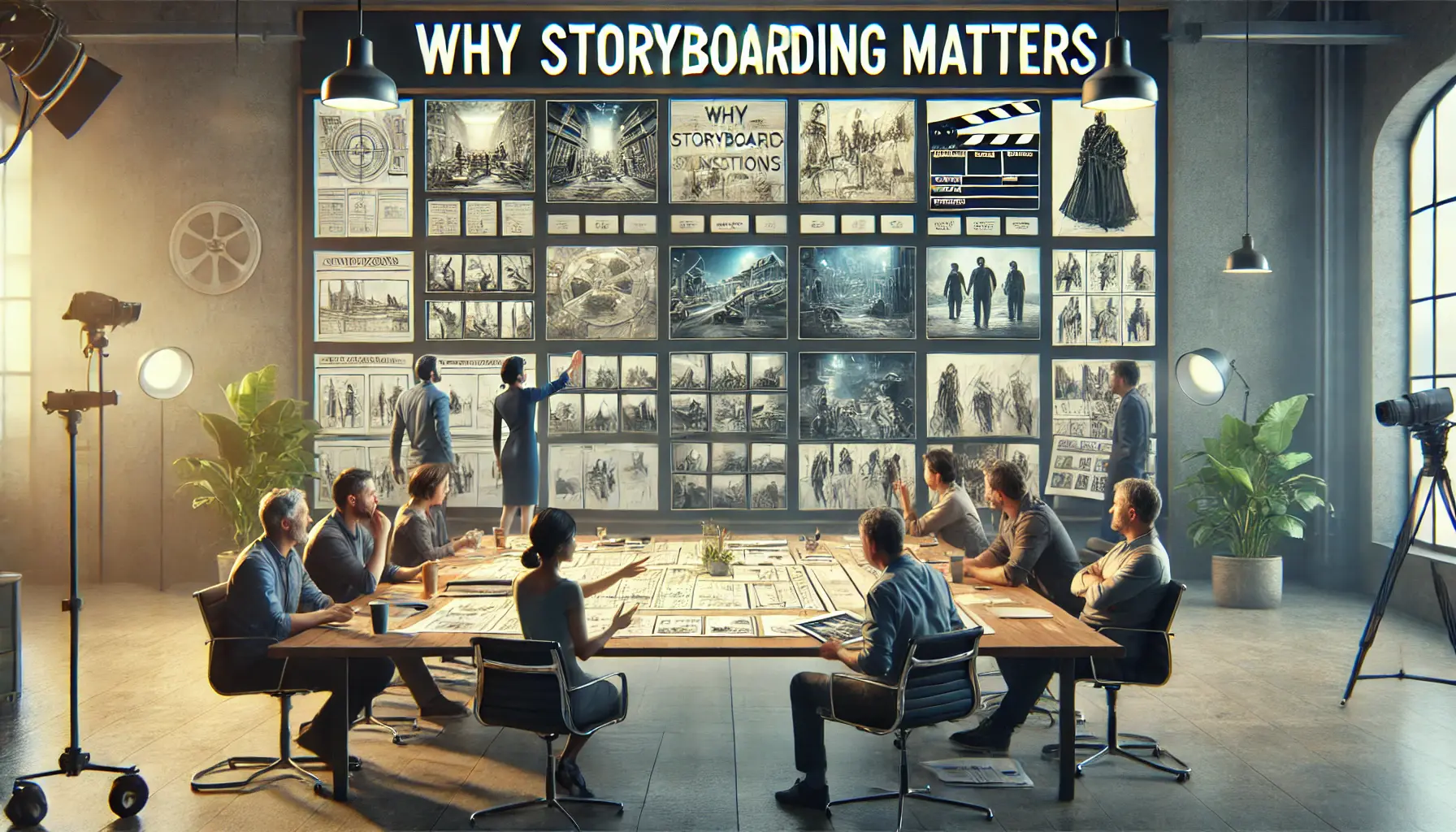
A professional creative team collaborating on the importance of storyboarding to shape the narrative of a project.
Why Storyboarding Matters
In a competitive advertising landscape, leveraging effective storyboarding techniques ensures that your campaigns stand out.
From enhancing team collaboration to aligning creative ideas with strategic goals, storyboarding bridges the gap between concept and execution.
This process not only saves time and resources but also results in advertisements that resonate deeply with your audience.

An inspiring moment of standing at the threshold, symbolizing the next step forward in a journey.
Take the Next Step
With storyboarding now a far less alien concept, it’s time to put these insights into practice.
Mastering these storyboarding techniques will surely enable you to create impactful advertisements that drive results—whether it’s launching a new product, rebranding, or reaching a broader audience.
This powerful tool will help you bring your creative vision to life with precision and success.
Mastering storyboarding techniques can significantly enhance the quality and effectiveness of your advertisements, driving better engagement and results.
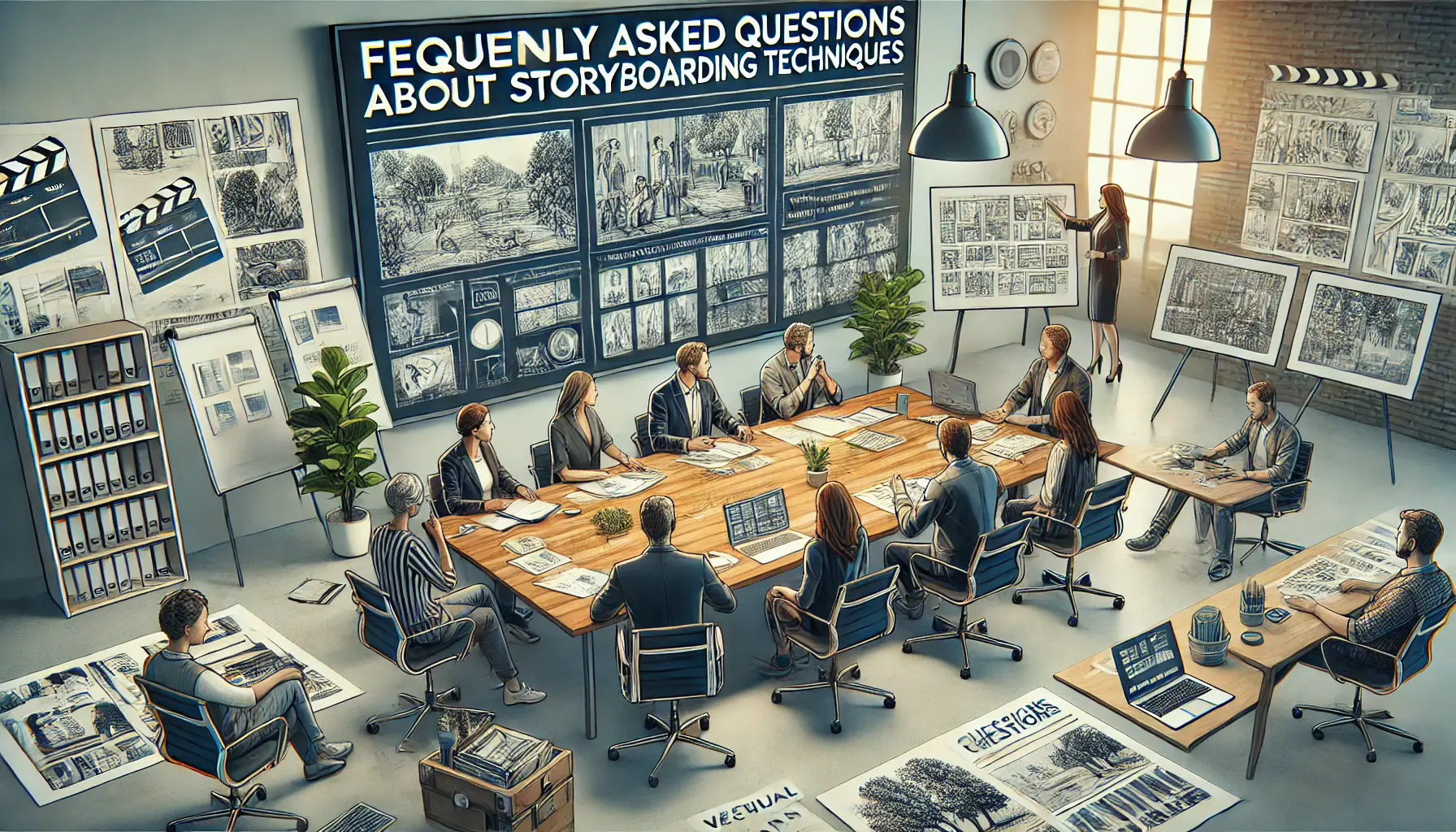
A team of professionals collaborating on understanding and clarifying storyboarding techniques.
Your campaigns can be managed by an agency specialized in Google Ads, check out our service page.
Frequently Asked Questions about Storyboarding Techniques
Storyboarding is a vital aspect of creating effective advertisements.
Below are some common questions and concise answers to enhance your understanding of this process.
Storyboarding involves creating a visual sequence of your ad’s scenes, outlining the narrative flow, camera angles, and key messages to effectively plan and communicate the advertisement’s structure.
Storyboarding allows advertisers to visualize and fine-tune the creative concept before production, ensuring a cohesive narrative and identifying potential issues early, which saves time and resources.
Essential components include visual frames depicting scenes, concise scene descriptions, dialogue or voiceover text, camera directions, and notes on timing and transitions.
Storyboarding serves as a reference point for everyone involved in the project, from designers to editors, facilitating better communication and alignment on the creative vision.
Yes, by planning visuals and transitions in advance, storyboarding helps create engaging and memorable ads that resonate with the target audience.
Common tools include digital software like Storyboarder by Wonder Unit, Toon Boom Storyboard Pro, and Boords, as well as traditional methods like sketchbooks and basic art supplies.
It depends on personal preference.
Digital tools offer editing flexibility, while traditional methods provide a tactile experience.
Both can be effective in planning your advertisement.
A storyboard should be detailed enough to convey the sequence of events, camera angles, and key actions, but it doesn’t need to be overly intricate.
Clarity is more important than artistic perfection.
Storyboards should be revisited and refined regularly based on feedback and testing to enhance the overall effectiveness of your advertisement.
